Enterprise Resource Planning (ERP) Report: Nestle and PG&E Analysis
VerifiedAdded on 2022/12/26
|21
|4848
|57
Report
AI Summary
This report provides a comprehensive overview of Enterprise Resource Planning (ERP), a crucial business software management process. It begins by introducing the concept of ERP and its importance in modern organizations, illustrated through case studies of Nestle and PG&E. The report highlights the benefits of ERP, such as improved efficiency, better resource management, and enhanced decision-making, referencing Nestle's successful implementation. Conversely, it discusses the failures encountered by PG&E due to improper ERP implementation. Furthermore, the report delves into the ongoing evolution of ERP, including the emergence of mobile, social, and cloud-based systems. It also outlines the stages involved in ERP processing, from planning and discovery to deployment, and the benefits and barriers associated with each stage. The report concludes by emphasizing the critical role of ERP in maintaining a competitive edge in today's dynamic business environment.
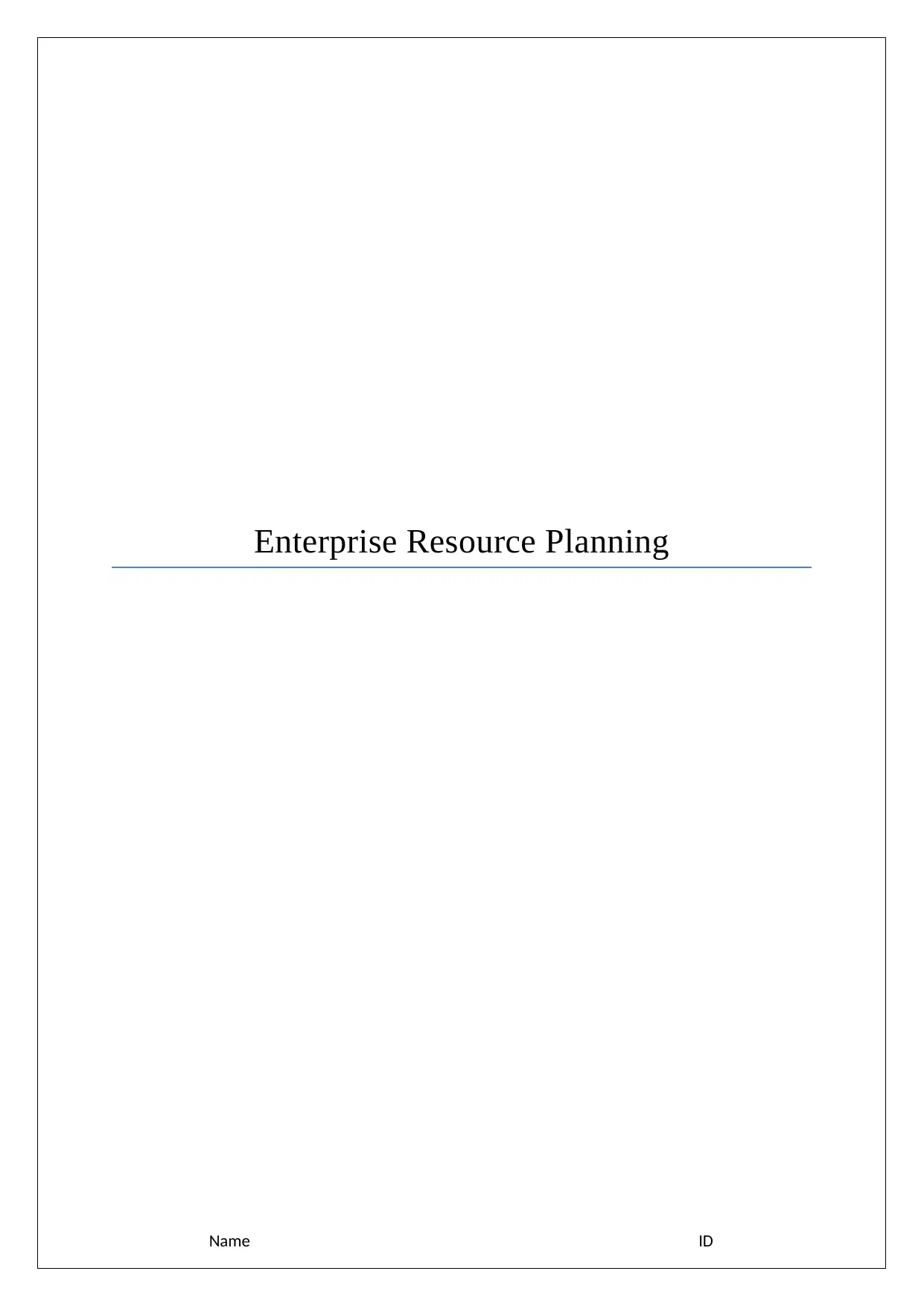
Enterprise Resource Planning
Name ID
Name ID
Secure Best Marks with AI Grader
Need help grading? Try our AI Grader for instant feedback on your assignments.
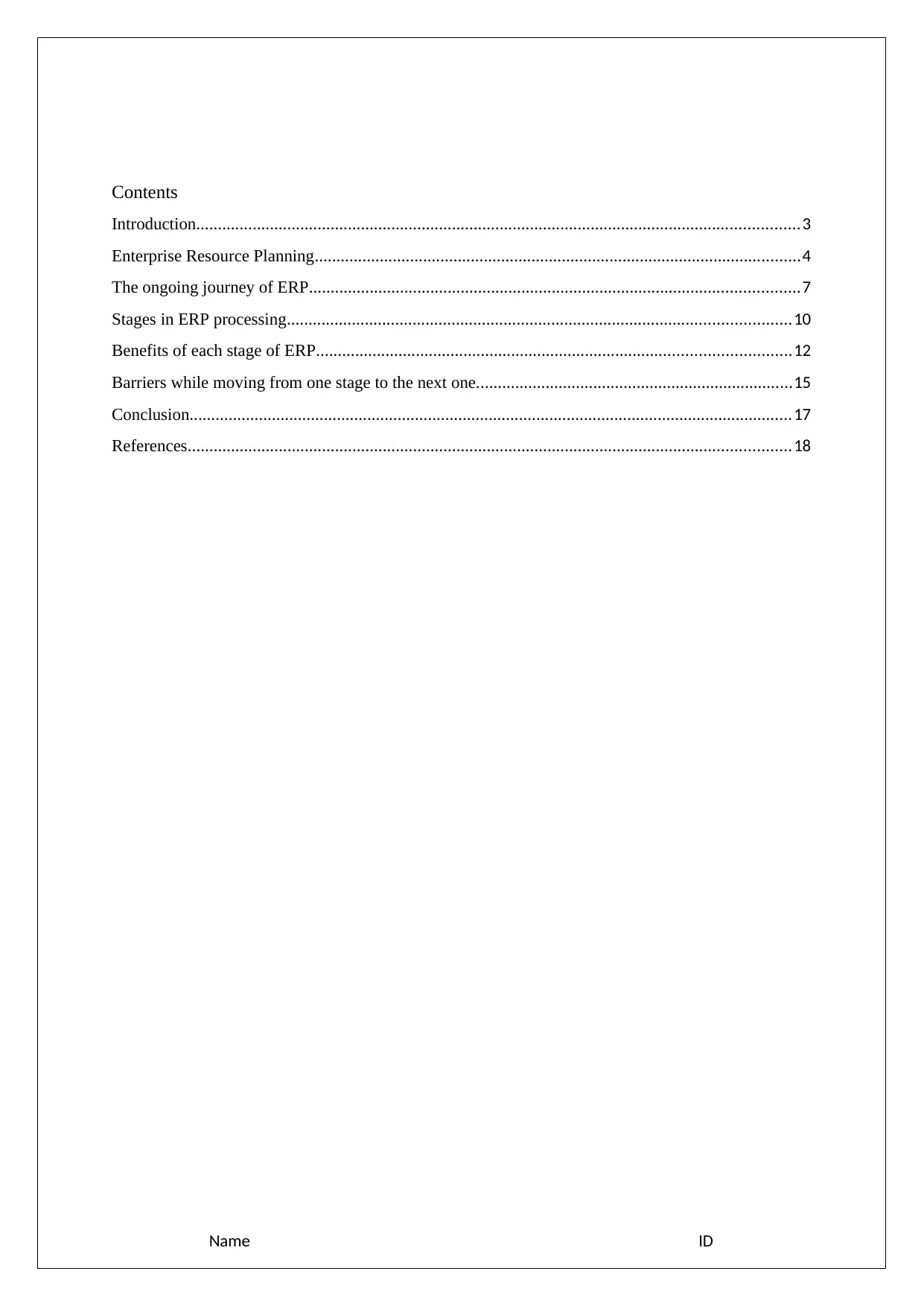
Contents
Introduction...........................................................................................................................................3
Enterprise Resource Planning................................................................................................................4
The ongoing journey of ERP.................................................................................................................7
Stages in ERP processing....................................................................................................................10
Benefits of each stage of ERP.............................................................................................................12
Barriers while moving from one stage to the next one.........................................................................15
Conclusion...........................................................................................................................................17
References...........................................................................................................................................18
Name ID
Introduction...........................................................................................................................................3
Enterprise Resource Planning................................................................................................................4
The ongoing journey of ERP.................................................................................................................7
Stages in ERP processing....................................................................................................................10
Benefits of each stage of ERP.............................................................................................................12
Barriers while moving from one stage to the next one.........................................................................15
Conclusion...........................................................................................................................................17
References...........................................................................................................................................18
Name ID
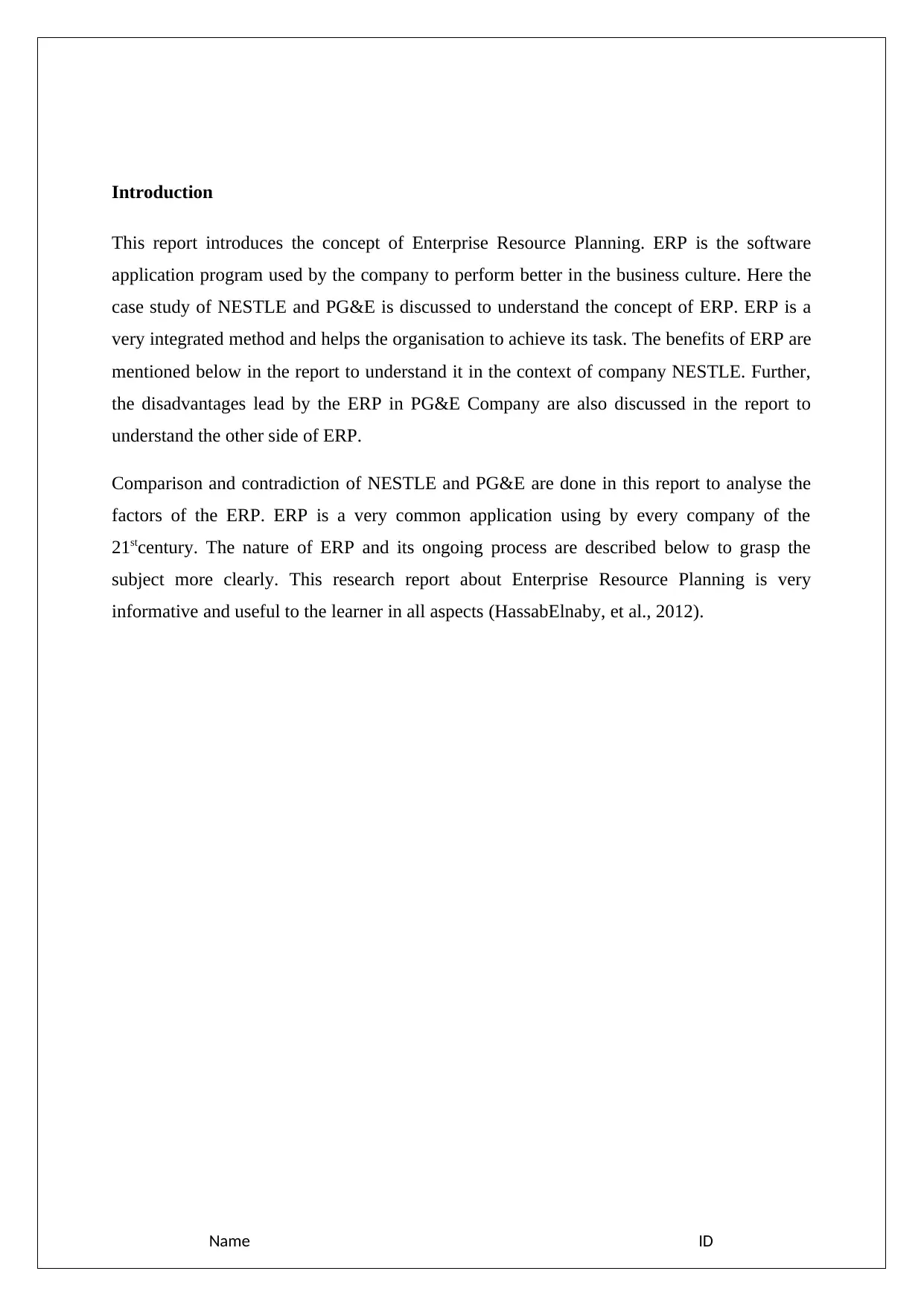
Introduction
This report introduces the concept of Enterprise Resource Planning. ERP is the software
application program used by the company to perform better in the business culture. Here the
case study of NESTLE and PG&E is discussed to understand the concept of ERP. ERP is a
very integrated method and helps the organisation to achieve its task. The benefits of ERP are
mentioned below in the report to understand it in the context of company NESTLE. Further,
the disadvantages lead by the ERP in PG&E Company are also discussed in the report to
understand the other side of ERP.
Comparison and contradiction of NESTLE and PG&E are done in this report to analyse the
factors of the ERP. ERP is a very common application using by every company of the
21stcentury. The nature of ERP and its ongoing process are described below to grasp the
subject more clearly. This research report about Enterprise Resource Planning is very
informative and useful to the learner in all aspects (HassabElnaby, et al., 2012).
Name ID
This report introduces the concept of Enterprise Resource Planning. ERP is the software
application program used by the company to perform better in the business culture. Here the
case study of NESTLE and PG&E is discussed to understand the concept of ERP. ERP is a
very integrated method and helps the organisation to achieve its task. The benefits of ERP are
mentioned below in the report to understand it in the context of company NESTLE. Further,
the disadvantages lead by the ERP in PG&E Company are also discussed in the report to
understand the other side of ERP.
Comparison and contradiction of NESTLE and PG&E are done in this report to analyse the
factors of the ERP. ERP is a very common application using by every company of the
21stcentury. The nature of ERP and its ongoing process are described below to grasp the
subject more clearly. This research report about Enterprise Resource Planning is very
informative and useful to the learner in all aspects (HassabElnaby, et al., 2012).
Name ID
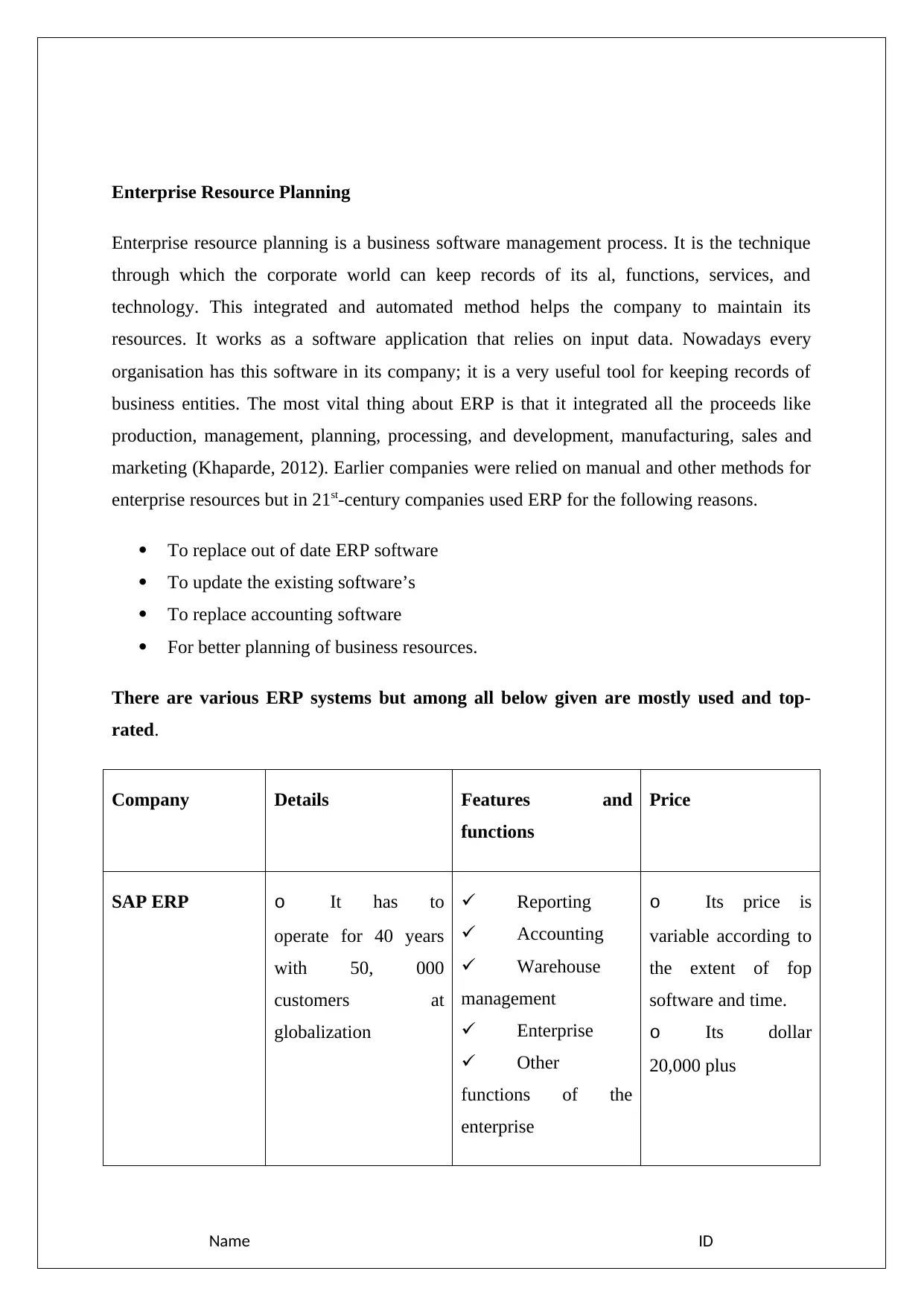
Enterprise Resource Planning
Enterprise resource planning is a business software management process. It is the technique
through which the corporate world can keep records of its al, functions, services, and
technology. This integrated and automated method helps the company to maintain its
resources. It works as a software application that relies on input data. Nowadays every
organisation has this software in its company; it is a very useful tool for keeping records of
business entities. The most vital thing about ERP is that it integrated all the proceeds like
production, management, planning, processing, and development, manufacturing, sales and
marketing (Khaparde, 2012). Earlier companies were relied on manual and other methods for
enterprise resources but in 21st-century companies used ERP for the following reasons.
To replace out of date ERP software
To update the existing software’s
To replace accounting software
For better planning of business resources.
There are various ERP systems but among all below given are mostly used and top-
rated.
Company Details Features and
functions
Price
SAP ERP o It has to
operate for 40 years
with 50, 000
customers at
globalization
Reporting
Accounting
Warehouse
management
Enterprise
Other
functions of the
enterprise
o Its price is
variable according to
the extent of fop
software and time.
o Its dollar
20,000 plus
Name ID
Enterprise resource planning is a business software management process. It is the technique
through which the corporate world can keep records of its al, functions, services, and
technology. This integrated and automated method helps the company to maintain its
resources. It works as a software application that relies on input data. Nowadays every
organisation has this software in its company; it is a very useful tool for keeping records of
business entities. The most vital thing about ERP is that it integrated all the proceeds like
production, management, planning, processing, and development, manufacturing, sales and
marketing (Khaparde, 2012). Earlier companies were relied on manual and other methods for
enterprise resources but in 21st-century companies used ERP for the following reasons.
To replace out of date ERP software
To update the existing software’s
To replace accounting software
For better planning of business resources.
There are various ERP systems but among all below given are mostly used and top-
rated.
Company Details Features and
functions
Price
SAP ERP o It has to
operate for 40 years
with 50, 000
customers at
globalization
Reporting
Accounting
Warehouse
management
Enterprise
Other
functions of the
enterprise
o Its price is
variable according to
the extent of fop
software and time.
o Its dollar
20,000 plus
Name ID
Secure Best Marks with AI Grader
Need help grading? Try our AI Grader for instant feedback on your assignments.
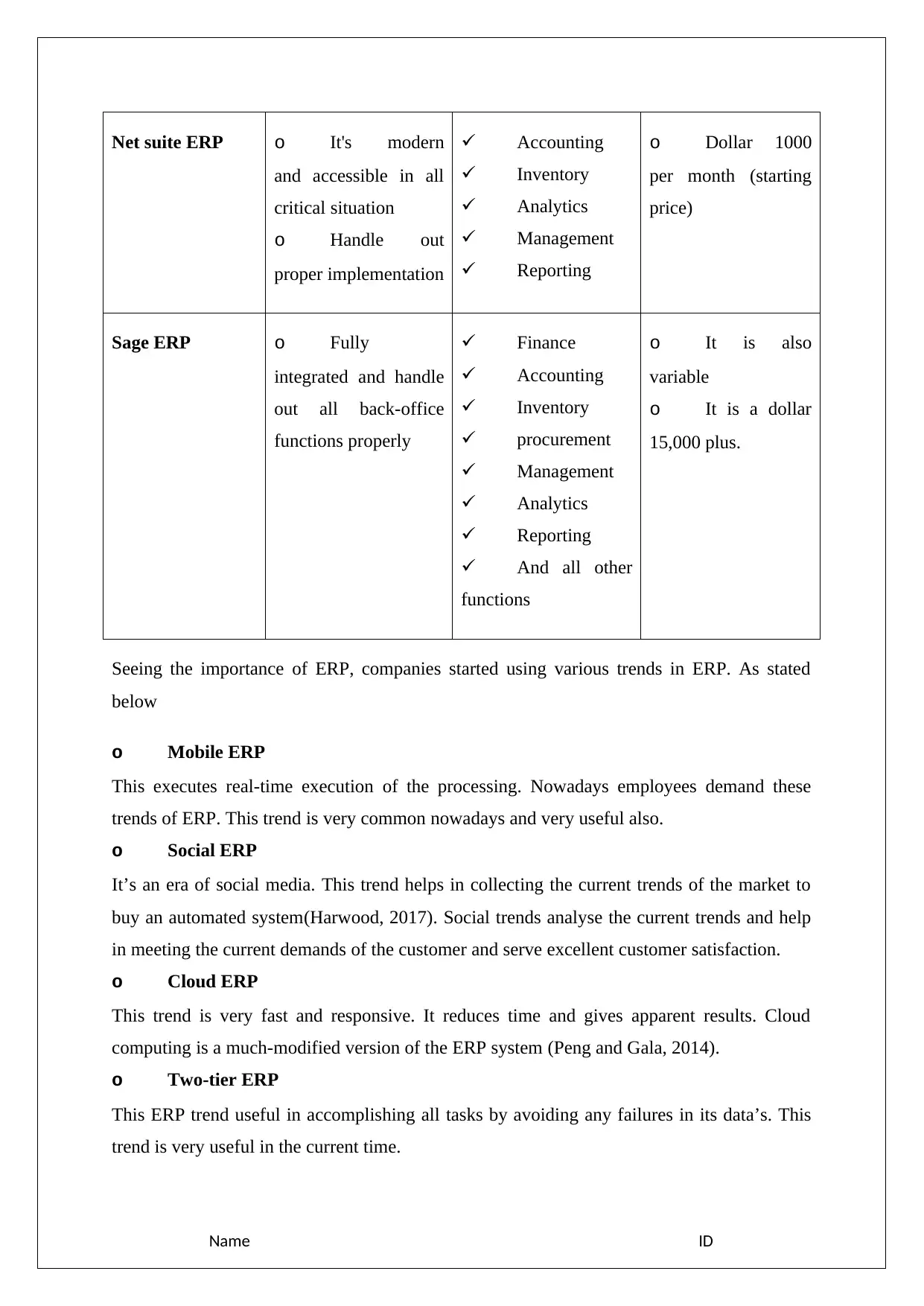
Net suite ERP o It's modern
and accessible in all
critical situation
o Handle out
proper implementation
Accounting
Inventory
Analytics
Management
Reporting
o Dollar 1000
per month (starting
price)
Sage ERP o Fully
integrated and handle
out all back-office
functions properly
Finance
Accounting
Inventory
procurement
Management
Analytics
Reporting
And all other
functions
o It is also
variable
o It is a dollar
15,000 plus.
Seeing the importance of ERP, companies started using various trends in ERP. As stated
below
o Mobile ERP
This executes real-time execution of the processing. Nowadays employees demand these
trends of ERP. This trend is very common nowadays and very useful also.
o Social ERP
It’s an era of social media. This trend helps in collecting the current trends of the market to
buy an automated system(Harwood, 2017). Social trends analyse the current trends and help
in meeting the current demands of the customer and serve excellent customer satisfaction.
o Cloud ERP
This trend is very fast and responsive. It reduces time and gives apparent results. Cloud
computing is a much-modified version of the ERP system (Peng and Gala, 2014).
o Two-tier ERP
This ERP trend useful in accomplishing all tasks by avoiding any failures in its data’s. This
trend is very useful in the current time.
Name ID
and accessible in all
critical situation
o Handle out
proper implementation
Accounting
Inventory
Analytics
Management
Reporting
o Dollar 1000
per month (starting
price)
Sage ERP o Fully
integrated and handle
out all back-office
functions properly
Finance
Accounting
Inventory
procurement
Management
Analytics
Reporting
And all other
functions
o It is also
variable
o It is a dollar
15,000 plus.
Seeing the importance of ERP, companies started using various trends in ERP. As stated
below
o Mobile ERP
This executes real-time execution of the processing. Nowadays employees demand these
trends of ERP. This trend is very common nowadays and very useful also.
o Social ERP
It’s an era of social media. This trend helps in collecting the current trends of the market to
buy an automated system(Harwood, 2017). Social trends analyse the current trends and help
in meeting the current demands of the customer and serve excellent customer satisfaction.
o Cloud ERP
This trend is very fast and responsive. It reduces time and gives apparent results. Cloud
computing is a much-modified version of the ERP system (Peng and Gala, 2014).
o Two-tier ERP
This ERP trend useful in accomplishing all tasks by avoiding any failures in its data’s. This
trend is very useful in the current time.
Name ID
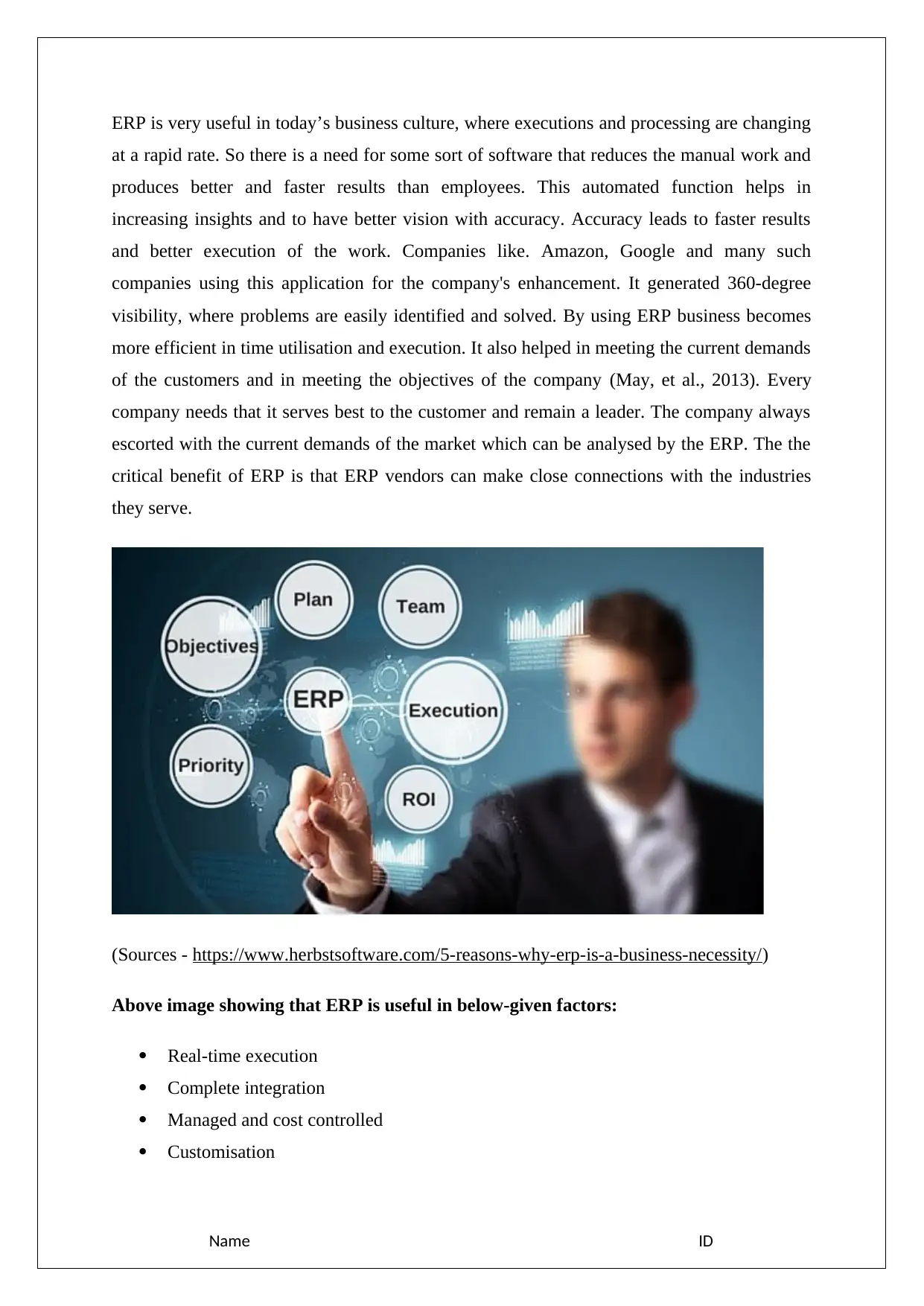
ERP is very useful in today’s business culture, where executions and processing are changing
at a rapid rate. So there is a need for some sort of software that reduces the manual work and
produces better and faster results than employees. This automated function helps in
increasing insights and to have better vision with accuracy. Accuracy leads to faster results
and better execution of the work. Companies like. Amazon, Google and many such
companies using this application for the company's enhancement. It generated 360-degree
visibility, where problems are easily identified and solved. By using ERP business becomes
more efficient in time utilisation and execution. It also helped in meeting the current demands
of the customers and in meeting the objectives of the company (May, et al., 2013). Every
company needs that it serves best to the customer and remain a leader. The company always
escorted with the current demands of the market which can be analysed by the ERP. The the
critical benefit of ERP is that ERP vendors can make close connections with the industries
they serve.
(Sources - https://www.herbstsoftware.com/5-reasons-why-erp-is-a-business-necessity/)
Above image showing that ERP is useful in below-given factors:
Real-time execution
Complete integration
Managed and cost controlled
Customisation
Name ID
at a rapid rate. So there is a need for some sort of software that reduces the manual work and
produces better and faster results than employees. This automated function helps in
increasing insights and to have better vision with accuracy. Accuracy leads to faster results
and better execution of the work. Companies like. Amazon, Google and many such
companies using this application for the company's enhancement. It generated 360-degree
visibility, where problems are easily identified and solved. By using ERP business becomes
more efficient in time utilisation and execution. It also helped in meeting the current demands
of the customers and in meeting the objectives of the company (May, et al., 2013). Every
company needs that it serves best to the customer and remain a leader. The company always
escorted with the current demands of the market which can be analysed by the ERP. The the
critical benefit of ERP is that ERP vendors can make close connections with the industries
they serve.
(Sources - https://www.herbstsoftware.com/5-reasons-why-erp-is-a-business-necessity/)
Above image showing that ERP is useful in below-given factors:
Real-time execution
Complete integration
Managed and cost controlled
Customisation
Name ID
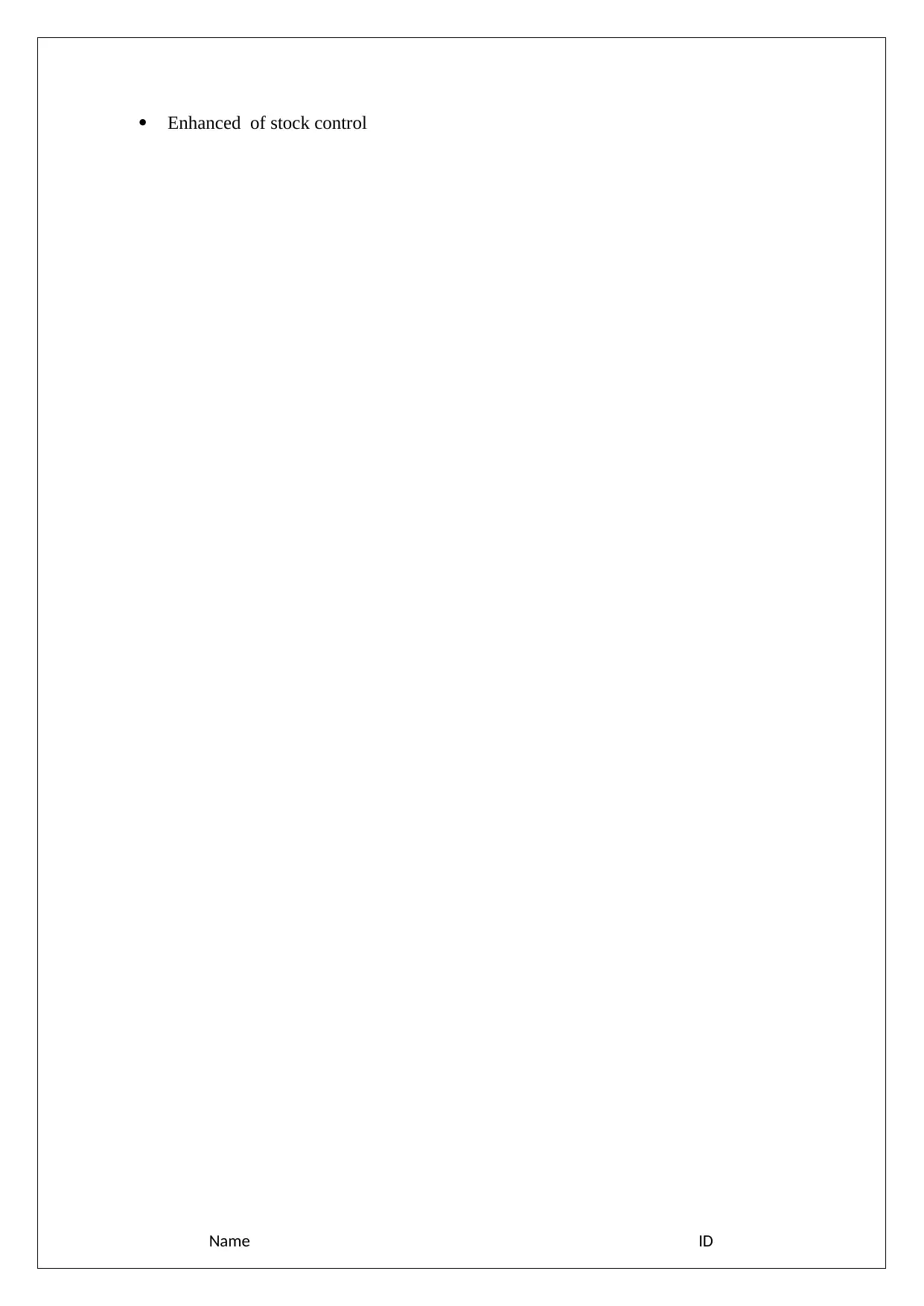
Enhanced of stock control
Name ID
Name ID
Paraphrase This Document
Need a fresh take? Get an instant paraphrase of this document with our AI Paraphraser
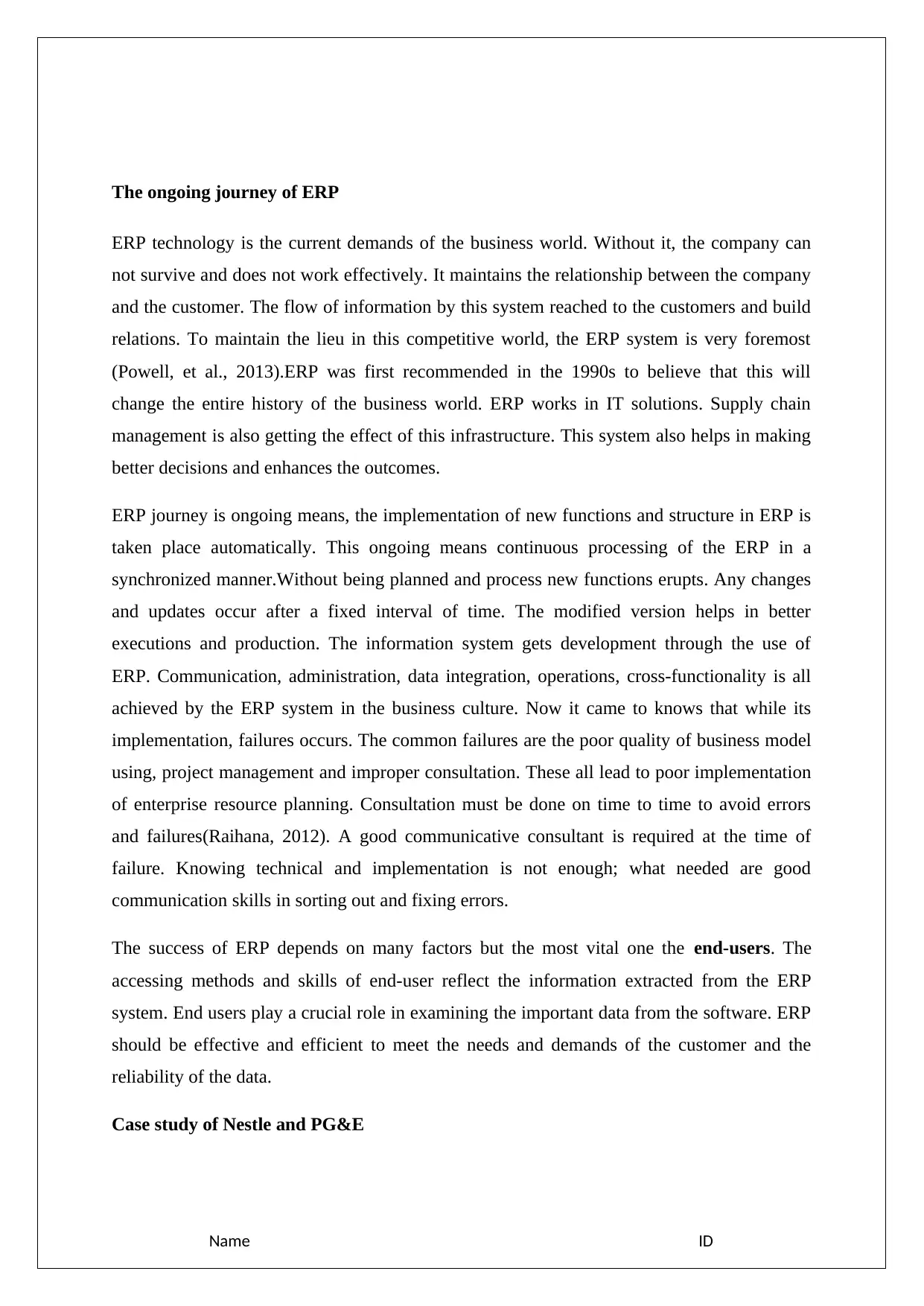
The ongoing journey of ERP
ERP technology is the current demands of the business world. Without it, the company can
not survive and does not work effectively. It maintains the relationship between the company
and the customer. The flow of information by this system reached to the customers and build
relations. To maintain the lieu in this competitive world, the ERP system is very foremost
(Powell, et al., 2013).ERP was first recommended in the 1990s to believe that this will
change the entire history of the business world. ERP works in IT solutions. Supply chain
management is also getting the effect of this infrastructure. This system also helps in making
better decisions and enhances the outcomes.
ERP journey is ongoing means, the implementation of new functions and structure in ERP is
taken place automatically. This ongoing means continuous processing of the ERP in a
synchronized manner.Without being planned and process new functions erupts. Any changes
and updates occur after a fixed interval of time. The modified version helps in better
executions and production. The information system gets development through the use of
ERP. Communication, administration, data integration, operations, cross-functionality is all
achieved by the ERP system in the business culture. Now it came to knows that while its
implementation, failures occurs. The common failures are the poor quality of business model
using, project management and improper consultation. These all lead to poor implementation
of enterprise resource planning. Consultation must be done on time to time to avoid errors
and failures(Raihana, 2012). A good communicative consultant is required at the time of
failure. Knowing technical and implementation is not enough; what needed are good
communication skills in sorting out and fixing errors.
The success of ERP depends on many factors but the most vital one the end-users. The
accessing methods and skills of end-user reflect the information extracted from the ERP
system. End users play a crucial role in examining the important data from the software. ERP
should be effective and efficient to meet the needs and demands of the customer and the
reliability of the data.
Case study of Nestle and PG&E
Name ID
ERP technology is the current demands of the business world. Without it, the company can
not survive and does not work effectively. It maintains the relationship between the company
and the customer. The flow of information by this system reached to the customers and build
relations. To maintain the lieu in this competitive world, the ERP system is very foremost
(Powell, et al., 2013).ERP was first recommended in the 1990s to believe that this will
change the entire history of the business world. ERP works in IT solutions. Supply chain
management is also getting the effect of this infrastructure. This system also helps in making
better decisions and enhances the outcomes.
ERP journey is ongoing means, the implementation of new functions and structure in ERP is
taken place automatically. This ongoing means continuous processing of the ERP in a
synchronized manner.Without being planned and process new functions erupts. Any changes
and updates occur after a fixed interval of time. The modified version helps in better
executions and production. The information system gets development through the use of
ERP. Communication, administration, data integration, operations, cross-functionality is all
achieved by the ERP system in the business culture. Now it came to knows that while its
implementation, failures occurs. The common failures are the poor quality of business model
using, project management and improper consultation. These all lead to poor implementation
of enterprise resource planning. Consultation must be done on time to time to avoid errors
and failures(Raihana, 2012). A good communicative consultant is required at the time of
failure. Knowing technical and implementation is not enough; what needed are good
communication skills in sorting out and fixing errors.
The success of ERP depends on many factors but the most vital one the end-users. The
accessing methods and skills of end-user reflect the information extracted from the ERP
system. End users play a crucial role in examining the important data from the software. ERP
should be effective and efficient to meet the needs and demands of the customer and the
reliability of the data.
Case study of Nestle and PG&E
Name ID
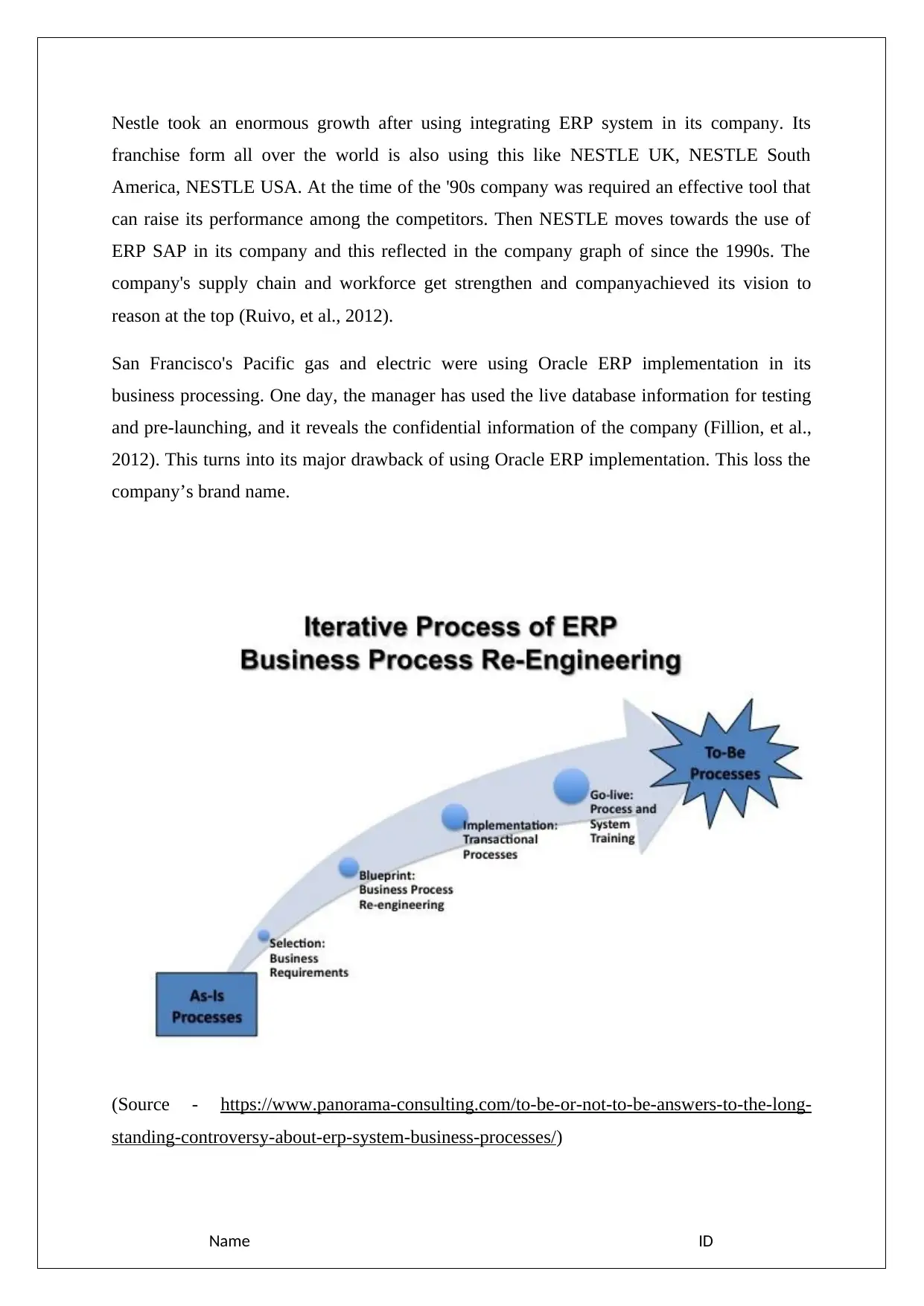
Nestle took an enormous growth after using integrating ERP system in its company. Its
franchise form all over the world is also using this like NESTLE UK, NESTLE South
America, NESTLE USA. At the time of the '90s company was required an effective tool that
can raise its performance among the competitors. Then NESTLE moves towards the use of
ERP SAP in its company and this reflected in the company graph of since the 1990s. The
company's supply chain and workforce get strengthen and companyachieved its vision to
reason at the top (Ruivo, et al., 2012).
San Francisco's Pacific gas and electric were using Oracle ERP implementation in its
business processing. One day, the manager has used the live database information for testing
and pre-launching, and it reveals the confidential information of the company (Fillion, et al.,
2012). This turns into its major drawback of using Oracle ERP implementation. This loss the
company’s brand name.
(Source - https://www.panorama-consulting.com/to-be-or-not-to-be-answers-to-the-long-
standing-controversy-about-erp-system-business-processes/)
Name ID
franchise form all over the world is also using this like NESTLE UK, NESTLE South
America, NESTLE USA. At the time of the '90s company was required an effective tool that
can raise its performance among the competitors. Then NESTLE moves towards the use of
ERP SAP in its company and this reflected in the company graph of since the 1990s. The
company's supply chain and workforce get strengthen and companyachieved its vision to
reason at the top (Ruivo, et al., 2012).
San Francisco's Pacific gas and electric were using Oracle ERP implementation in its
business processing. One day, the manager has used the live database information for testing
and pre-launching, and it reveals the confidential information of the company (Fillion, et al.,
2012). This turns into its major drawback of using Oracle ERP implementation. This loss the
company’s brand name.
(Source - https://www.panorama-consulting.com/to-be-or-not-to-be-answers-to-the-long-
standing-controversy-about-erp-system-business-processes/)
Name ID
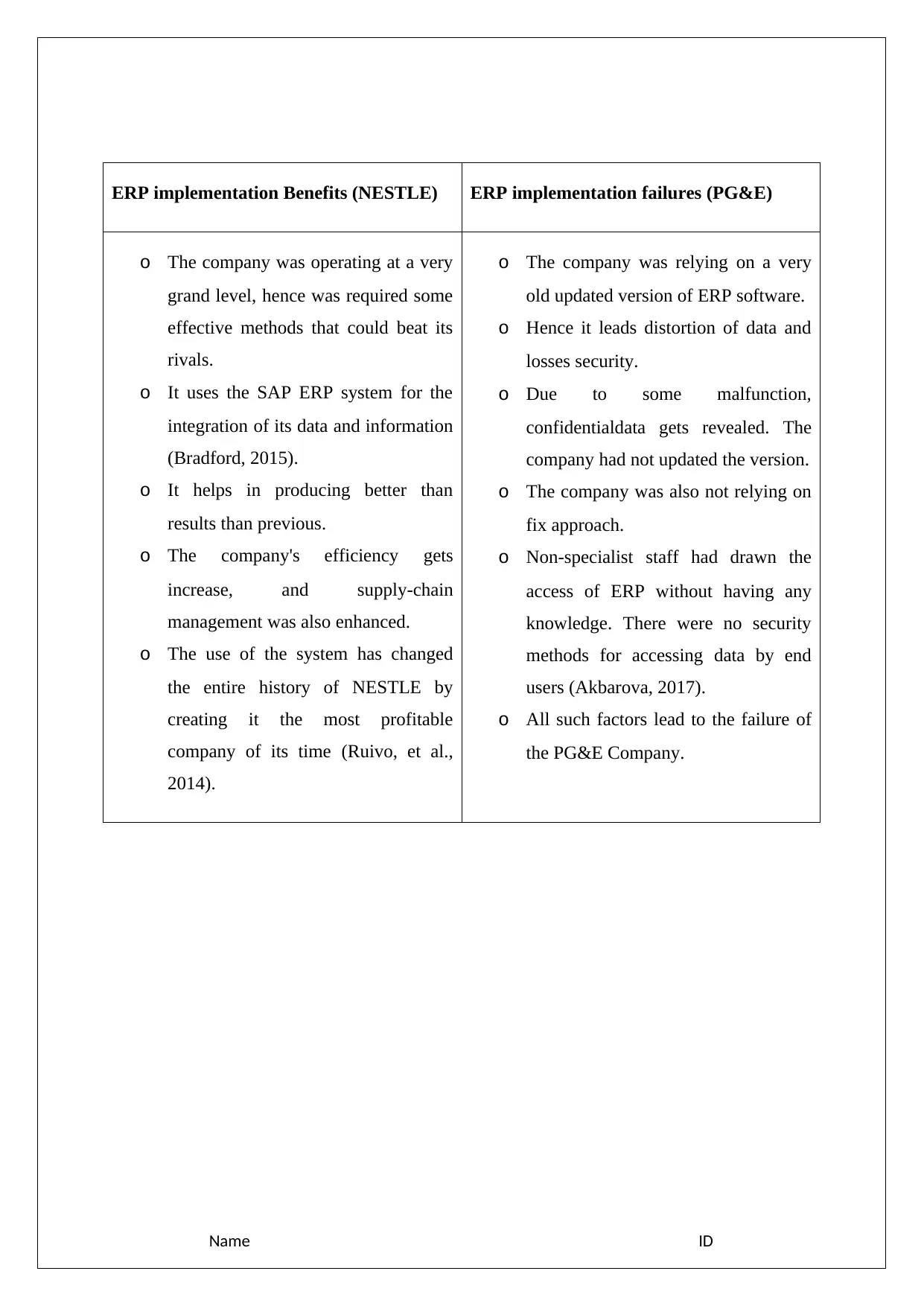
ERP implementation Benefits (NESTLE) ERP implementation failures (PG&E)
o The company was operating at a very
grand level, hence was required some
effective methods that could beat its
rivals.
o It uses the SAP ERP system for the
integration of its data and information
(Bradford, 2015).
o It helps in producing better than
results than previous.
o The company's efficiency gets
increase, and supply-chain
management was also enhanced.
o The use of the system has changed
the entire history of NESTLE by
creating it the most profitable
company of its time (Ruivo, et al.,
2014).
o The company was relying on a very
old updated version of ERP software.
o Hence it leads distortion of data and
losses security.
o Due to some malfunction,
confidentialdata gets revealed. The
company had not updated the version.
o The company was also not relying on
fix approach.
o Non-specialist staff had drawn the
access of ERP without having any
knowledge. There were no security
methods for accessing data by end
users (Akbarova, 2017).
o All such factors lead to the failure of
the PG&E Company.
Name ID
o The company was operating at a very
grand level, hence was required some
effective methods that could beat its
rivals.
o It uses the SAP ERP system for the
integration of its data and information
(Bradford, 2015).
o It helps in producing better than
results than previous.
o The company's efficiency gets
increase, and supply-chain
management was also enhanced.
o The use of the system has changed
the entire history of NESTLE by
creating it the most profitable
company of its time (Ruivo, et al.,
2014).
o The company was relying on a very
old updated version of ERP software.
o Hence it leads distortion of data and
losses security.
o Due to some malfunction,
confidentialdata gets revealed. The
company had not updated the version.
o The company was also not relying on
fix approach.
o Non-specialist staff had drawn the
access of ERP without having any
knowledge. There were no security
methods for accessing data by end
users (Akbarova, 2017).
o All such factors lead to the failure of
the PG&E Company.
Name ID
Secure Best Marks with AI Grader
Need help grading? Try our AI Grader for instant feedback on your assignments.
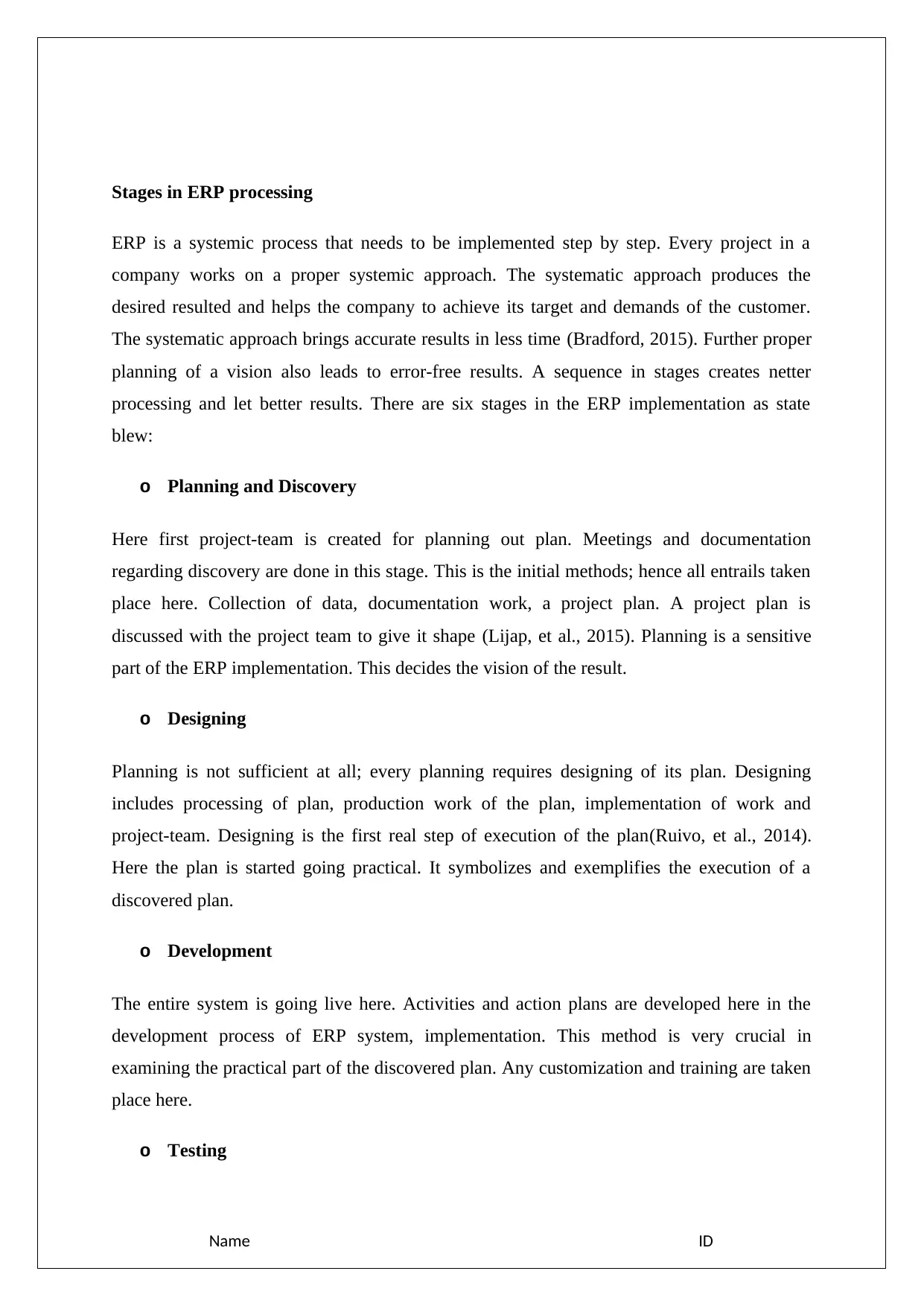
Stages in ERP processing
ERP is a systemic process that needs to be implemented step by step. Every project in a
company works on a proper systemic approach. The systematic approach produces the
desired resulted and helps the company to achieve its target and demands of the customer.
The systematic approach brings accurate results in less time (Bradford, 2015). Further proper
planning of a vision also leads to error-free results. A sequence in stages creates netter
processing and let better results. There are six stages in the ERP implementation as state
blew:
o Planning and Discovery
Here first project-team is created for planning out plan. Meetings and documentation
regarding discovery are done in this stage. This is the initial methods; hence all entrails taken
place here. Collection of data, documentation work, a project plan. A project plan is
discussed with the project team to give it shape (Lijap, et al., 2015). Planning is a sensitive
part of the ERP implementation. This decides the vision of the result.
o Designing
Planning is not sufficient at all; every planning requires designing of its plan. Designing
includes processing of plan, production work of the plan, implementation of work and
project-team. Designing is the first real step of execution of the plan(Ruivo, et al., 2014).
Here the plan is started going practical. It symbolizes and exemplifies the execution of a
discovered plan.
o Development
The entire system is going live here. Activities and action plans are developed here in the
development process of ERP system, implementation. This method is very crucial in
examining the practical part of the discovered plan. Any customization and training are taken
place here.
o Testing
Name ID
ERP is a systemic process that needs to be implemented step by step. Every project in a
company works on a proper systemic approach. The systematic approach produces the
desired resulted and helps the company to achieve its target and demands of the customer.
The systematic approach brings accurate results in less time (Bradford, 2015). Further proper
planning of a vision also leads to error-free results. A sequence in stages creates netter
processing and let better results. There are six stages in the ERP implementation as state
blew:
o Planning and Discovery
Here first project-team is created for planning out plan. Meetings and documentation
regarding discovery are done in this stage. This is the initial methods; hence all entrails taken
place here. Collection of data, documentation work, a project plan. A project plan is
discussed with the project team to give it shape (Lijap, et al., 2015). Planning is a sensitive
part of the ERP implementation. This decides the vision of the result.
o Designing
Planning is not sufficient at all; every planning requires designing of its plan. Designing
includes processing of plan, production work of the plan, implementation of work and
project-team. Designing is the first real step of execution of the plan(Ruivo, et al., 2014).
Here the plan is started going practical. It symbolizes and exemplifies the execution of a
discovered plan.
o Development
The entire system is going live here. Activities and action plans are developed here in the
development process of ERP system, implementation. This method is very crucial in
examining the practical part of the discovered plan. Any customization and training are taken
place here.
o Testing
Name ID
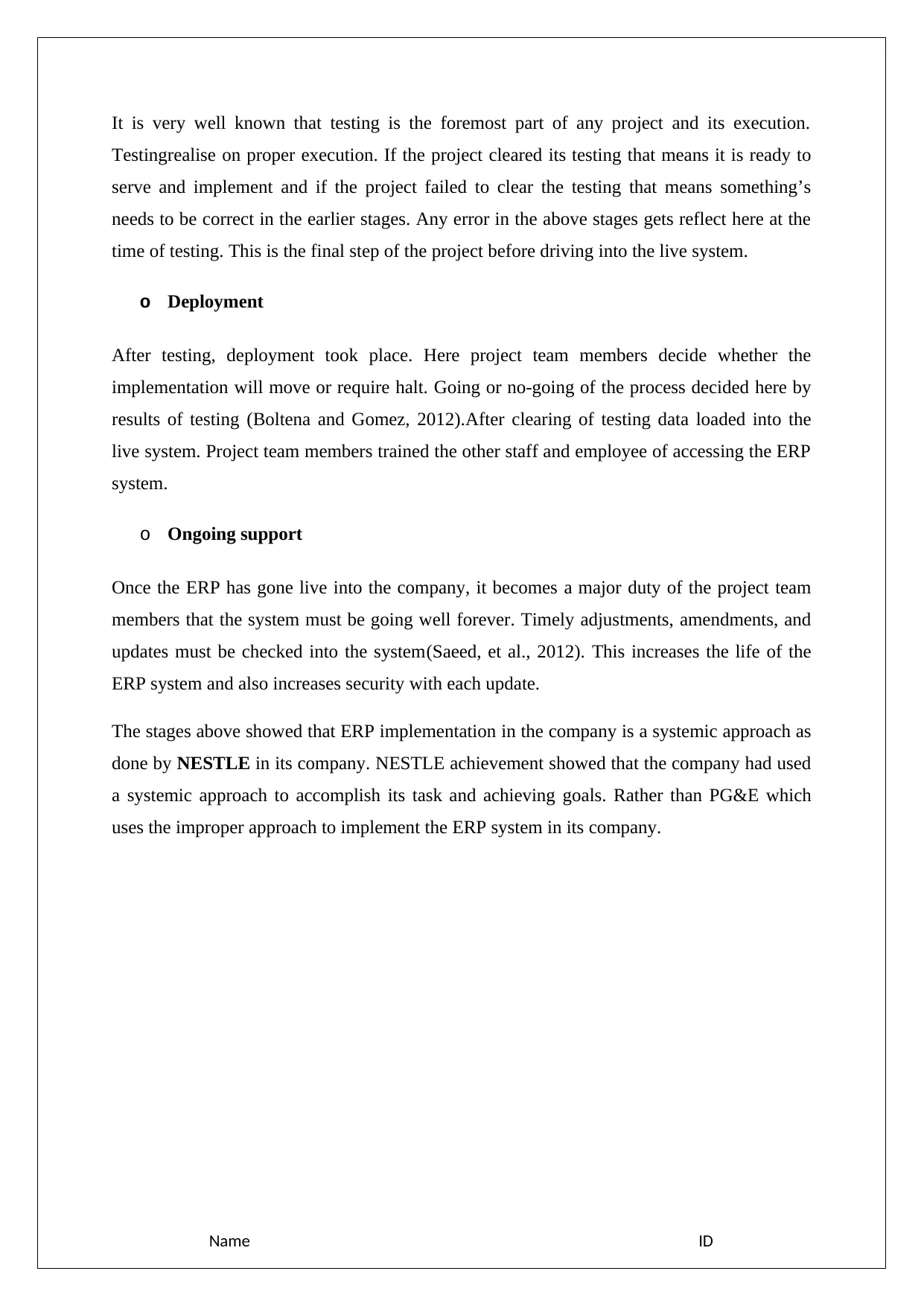
It is very well known that testing is the foremost part of any project and its execution.
Testingrealise on proper execution. If the project cleared its testing that means it is ready to
serve and implement and if the project failed to clear the testing that means something’s
needs to be correct in the earlier stages. Any error in the above stages gets reflect here at the
time of testing. This is the final step of the project before driving into the live system.
o Deployment
After testing, deployment took place. Here project team members decide whether the
implementation will move or require halt. Going or no-going of the process decided here by
results of testing (Boltena and Gomez, 2012).After clearing of testing data loaded into the
live system. Project team members trained the other staff and employee of accessing the ERP
system.
o Ongoing support
Once the ERP has gone live into the company, it becomes a major duty of the project team
members that the system must be going well forever. Timely adjustments, amendments, and
updates must be checked into the system(Saeed, et al., 2012). This increases the life of the
ERP system and also increases security with each update.
The stages above showed that ERP implementation in the company is a systemic approach as
done by NESTLE in its company. NESTLE achievement showed that the company had used
a systemic approach to accomplish its task and achieving goals. Rather than PG&E which
uses the improper approach to implement the ERP system in its company.
Name ID
Testingrealise on proper execution. If the project cleared its testing that means it is ready to
serve and implement and if the project failed to clear the testing that means something’s
needs to be correct in the earlier stages. Any error in the above stages gets reflect here at the
time of testing. This is the final step of the project before driving into the live system.
o Deployment
After testing, deployment took place. Here project team members decide whether the
implementation will move or require halt. Going or no-going of the process decided here by
results of testing (Boltena and Gomez, 2012).After clearing of testing data loaded into the
live system. Project team members trained the other staff and employee of accessing the ERP
system.
o Ongoing support
Once the ERP has gone live into the company, it becomes a major duty of the project team
members that the system must be going well forever. Timely adjustments, amendments, and
updates must be checked into the system(Saeed, et al., 2012). This increases the life of the
ERP system and also increases security with each update.
The stages above showed that ERP implementation in the company is a systemic approach as
done by NESTLE in its company. NESTLE achievement showed that the company had used
a systemic approach to accomplish its task and achieving goals. Rather than PG&E which
uses the improper approach to implement the ERP system in its company.
Name ID
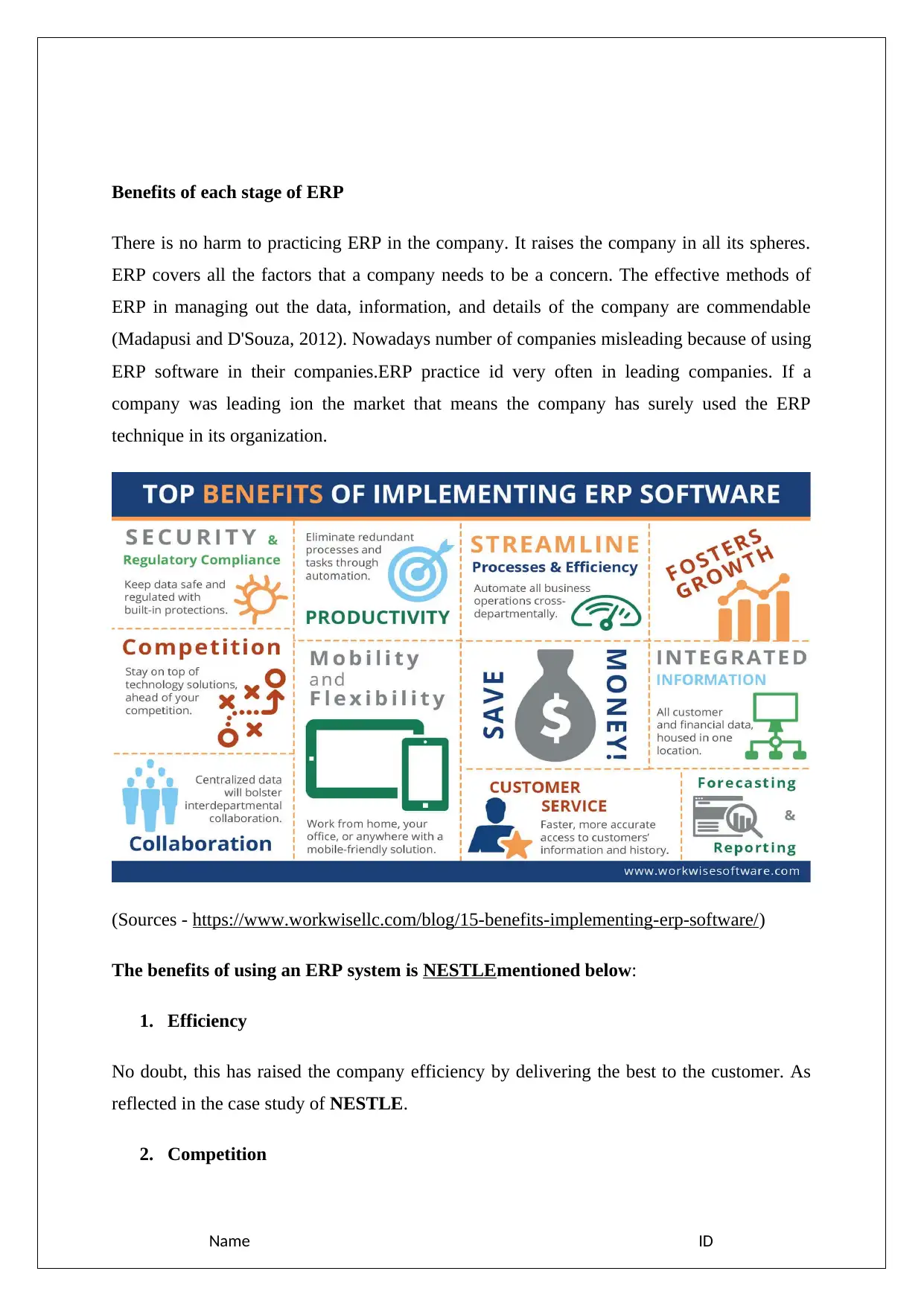
Benefits of each stage of ERP
There is no harm to practicing ERP in the company. It raises the company in all its spheres.
ERP covers all the factors that a company needs to be a concern. The effective methods of
ERP in managing out the data, information, and details of the company are commendable
(Madapusi and D'Souza, 2012). Nowadays number of companies misleading because of using
ERP software in their companies.ERP practice id very often in leading companies. If a
company was leading ion the market that means the company has surely used the ERP
technique in its organization.
(Sources - https://www.workwisellc.com/blog/15-benefits-implementing-erp-software/)
The benefits of using an ERP system is NESTLEmentioned below:
1. Efficiency
No doubt, this has raised the company efficiency by delivering the best to the customer. As
reflected in the case study of NESTLE.
2. Competition
Name ID
There is no harm to practicing ERP in the company. It raises the company in all its spheres.
ERP covers all the factors that a company needs to be a concern. The effective methods of
ERP in managing out the data, information, and details of the company are commendable
(Madapusi and D'Souza, 2012). Nowadays number of companies misleading because of using
ERP software in their companies.ERP practice id very often in leading companies. If a
company was leading ion the market that means the company has surely used the ERP
technique in its organization.
(Sources - https://www.workwisellc.com/blog/15-benefits-implementing-erp-software/)
The benefits of using an ERP system is NESTLEmentioned below:
1. Efficiency
No doubt, this has raised the company efficiency by delivering the best to the customer. As
reflected in the case study of NESTLE.
2. Competition
Name ID
Paraphrase This Document
Need a fresh take? Get an instant paraphrase of this document with our AI Paraphraser
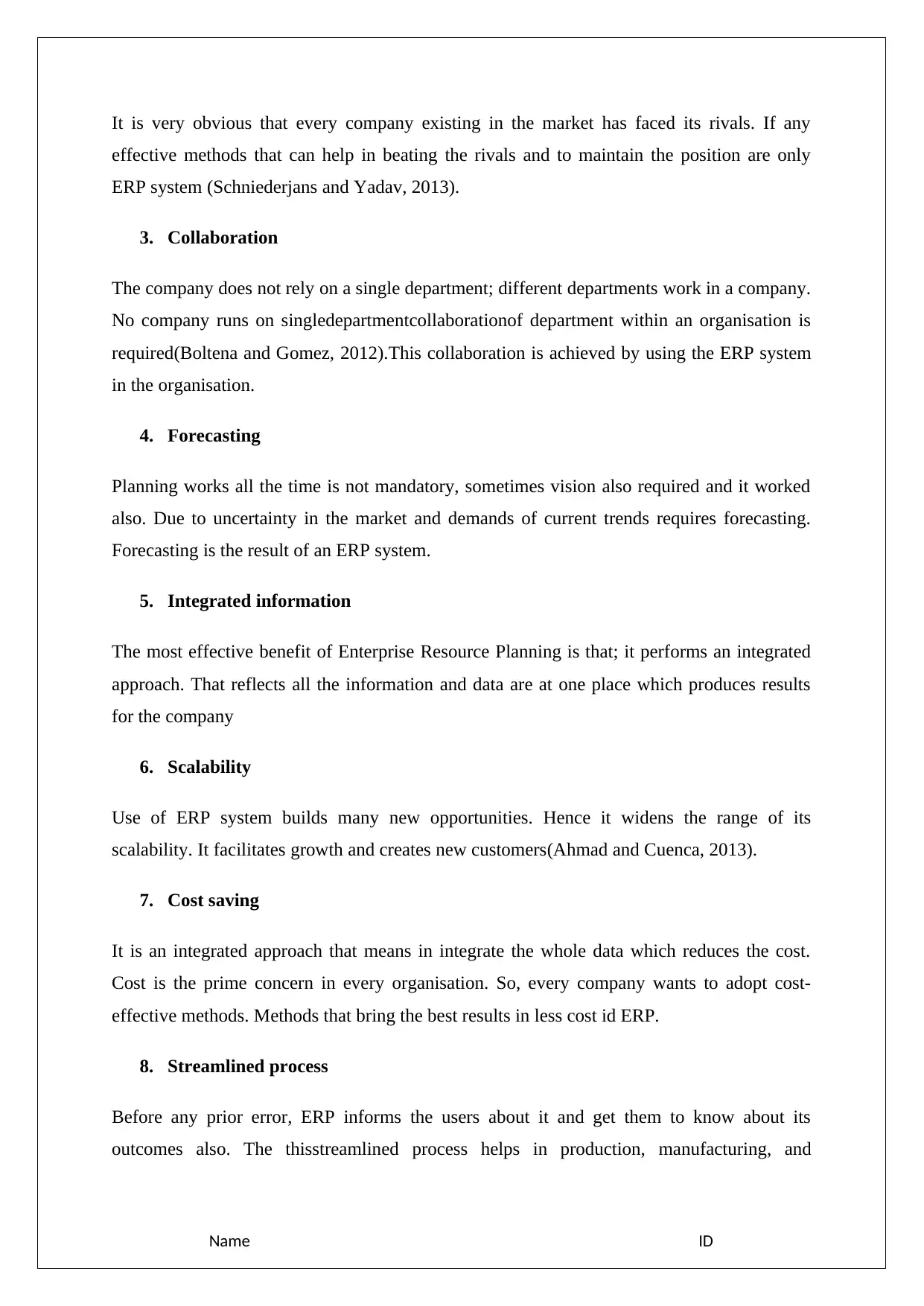
It is very obvious that every company existing in the market has faced its rivals. If any
effective methods that can help in beating the rivals and to maintain the position are only
ERP system (Schniederjans and Yadav, 2013).
3. Collaboration
The company does not rely on a single department; different departments work in a company.
No company runs on singledepartmentcollaborationof department within an organisation is
required(Boltena and Gomez, 2012).This collaboration is achieved by using the ERP system
in the organisation.
4. Forecasting
Planning works all the time is not mandatory, sometimes vision also required and it worked
also. Due to uncertainty in the market and demands of current trends requires forecasting.
Forecasting is the result of an ERP system.
5. Integrated information
The most effective benefit of Enterprise Resource Planning is that; it performs an integrated
approach. That reflects all the information and data are at one place which produces results
for the company
6. Scalability
Use of ERP system builds many new opportunities. Hence it widens the range of its
scalability. It facilitates growth and creates new customers(Ahmad and Cuenca, 2013).
7. Cost saving
It is an integrated approach that means in integrate the whole data which reduces the cost.
Cost is the prime concern in every organisation. So, every company wants to adopt cost-
effective methods. Methods that bring the best results in less cost id ERP.
8. Streamlined process
Before any prior error, ERP informs the users about it and get them to know about its
outcomes also. The thisstreamlined process helps in production, manufacturing, and
Name ID
effective methods that can help in beating the rivals and to maintain the position are only
ERP system (Schniederjans and Yadav, 2013).
3. Collaboration
The company does not rely on a single department; different departments work in a company.
No company runs on singledepartmentcollaborationof department within an organisation is
required(Boltena and Gomez, 2012).This collaboration is achieved by using the ERP system
in the organisation.
4. Forecasting
Planning works all the time is not mandatory, sometimes vision also required and it worked
also. Due to uncertainty in the market and demands of current trends requires forecasting.
Forecasting is the result of an ERP system.
5. Integrated information
The most effective benefit of Enterprise Resource Planning is that; it performs an integrated
approach. That reflects all the information and data are at one place which produces results
for the company
6. Scalability
Use of ERP system builds many new opportunities. Hence it widens the range of its
scalability. It facilitates growth and creates new customers(Ahmad and Cuenca, 2013).
7. Cost saving
It is an integrated approach that means in integrate the whole data which reduces the cost.
Cost is the prime concern in every organisation. So, every company wants to adopt cost-
effective methods. Methods that bring the best results in less cost id ERP.
8. Streamlined process
Before any prior error, ERP informs the users about it and get them to know about its
outcomes also. The thisstreamlined process helps in production, manufacturing, and
Name ID
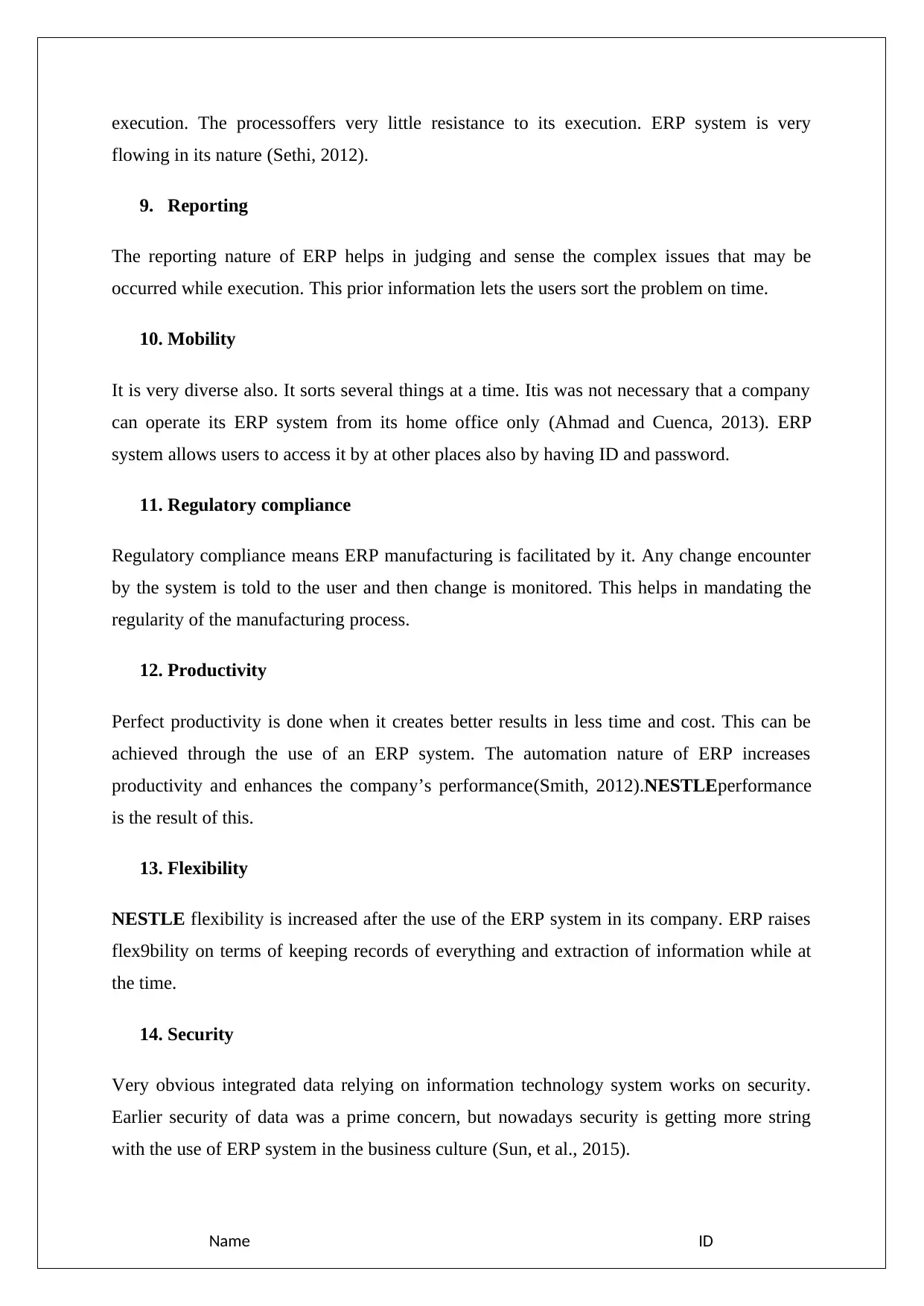
execution. The processoffers very little resistance to its execution. ERP system is very
flowing in its nature (Sethi, 2012).
9. Reporting
The reporting nature of ERP helps in judging and sense the complex issues that may be
occurred while execution. This prior information lets the users sort the problem on time.
10. Mobility
It is very diverse also. It sorts several things at a time. Itis was not necessary that a company
can operate its ERP system from its home office only (Ahmad and Cuenca, 2013). ERP
system allows users to access it by at other places also by having ID and password.
11. Regulatory compliance
Regulatory compliance means ERP manufacturing is facilitated by it. Any change encounter
by the system is told to the user and then change is monitored. This helps in mandating the
regularity of the manufacturing process.
12. Productivity
Perfect productivity is done when it creates better results in less time and cost. This can be
achieved through the use of an ERP system. The automation nature of ERP increases
productivity and enhances the company’s performance(Smith, 2012).NESTLEperformance
is the result of this.
13. Flexibility
NESTLE flexibility is increased after the use of the ERP system in its company. ERP raises
flex9bility on terms of keeping records of everything and extraction of information while at
the time.
14. Security
Very obvious integrated data relying on information technology system works on security.
Earlier security of data was a prime concern, but nowadays security is getting more string
with the use of ERP system in the business culture (Sun, et al., 2015).
Name ID
flowing in its nature (Sethi, 2012).
9. Reporting
The reporting nature of ERP helps in judging and sense the complex issues that may be
occurred while execution. This prior information lets the users sort the problem on time.
10. Mobility
It is very diverse also. It sorts several things at a time. Itis was not necessary that a company
can operate its ERP system from its home office only (Ahmad and Cuenca, 2013). ERP
system allows users to access it by at other places also by having ID and password.
11. Regulatory compliance
Regulatory compliance means ERP manufacturing is facilitated by it. Any change encounter
by the system is told to the user and then change is monitored. This helps in mandating the
regularity of the manufacturing process.
12. Productivity
Perfect productivity is done when it creates better results in less time and cost. This can be
achieved through the use of an ERP system. The automation nature of ERP increases
productivity and enhances the company’s performance(Smith, 2012).NESTLEperformance
is the result of this.
13. Flexibility
NESTLE flexibility is increased after the use of the ERP system in its company. ERP raises
flex9bility on terms of keeping records of everything and extraction of information while at
the time.
14. Security
Very obvious integrated data relying on information technology system works on security.
Earlier security of data was a prime concern, but nowadays security is getting more string
with the use of ERP system in the business culture (Sun, et al., 2015).
Name ID
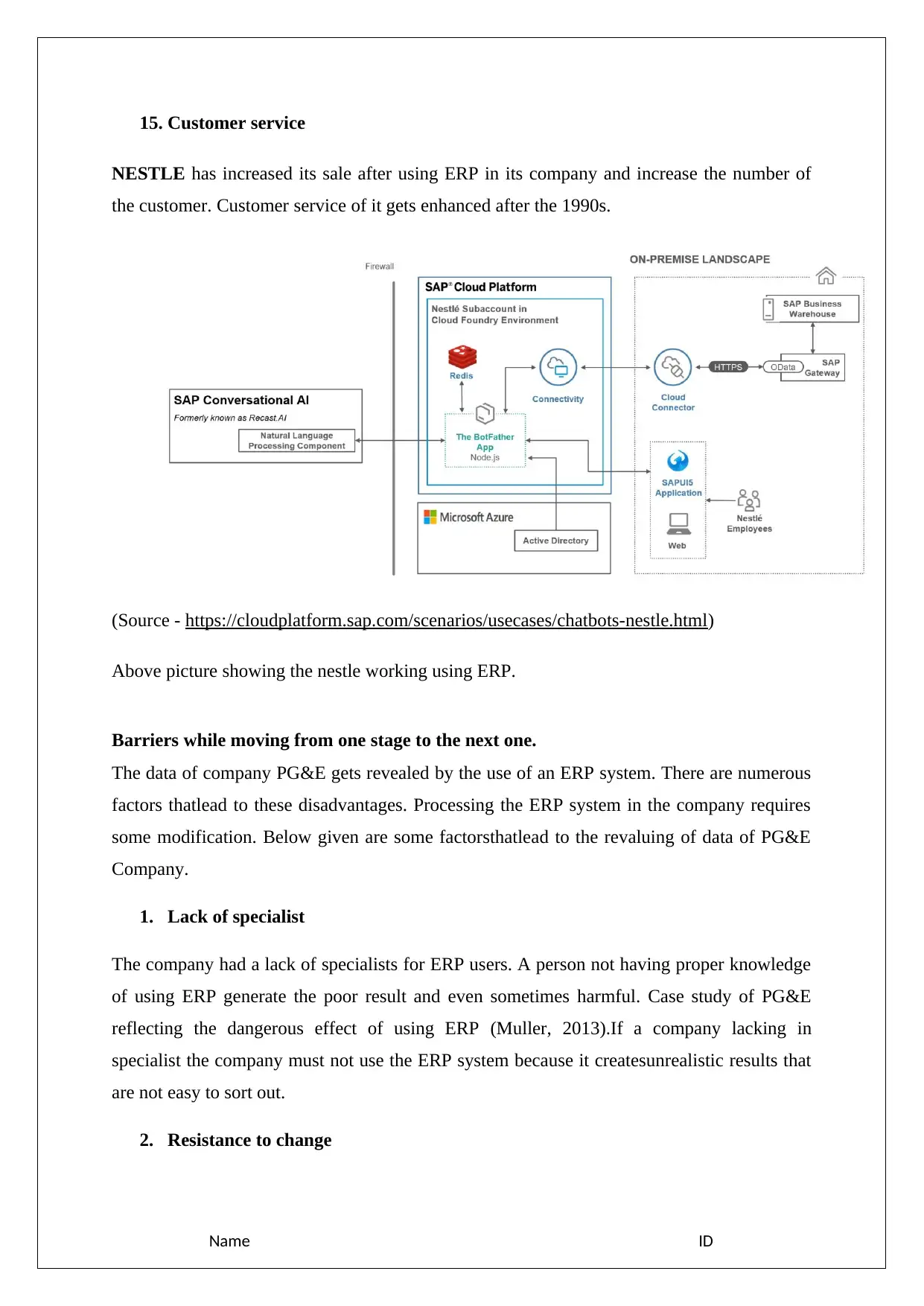
15. Customer service
NESTLE has increased its sale after using ERP in its company and increase the number of
the customer. Customer service of it gets enhanced after the 1990s.
(Source - https://cloudplatform.sap.com/scenarios/usecases/chatbots-nestle.html)
Above picture showing the nestle working using ERP.
Barriers while moving from one stage to the next one.
The data of company PG&E gets revealed by the use of an ERP system. There are numerous
factors thatlead to these disadvantages. Processing the ERP system in the company requires
some modification. Below given are some factorsthatlead to the revaluing of data of PG&E
Company.
1. Lack of specialist
The company had a lack of specialists for ERP users. A person not having proper knowledge
of using ERP generate the poor result and even sometimes harmful. Case study of PG&E
reflecting the dangerous effect of using ERP (Muller, 2013).If a company lacking in
specialist the company must not use the ERP system because it createsunrealistic results that
are not easy to sort out.
2. Resistance to change
Name ID
NESTLE has increased its sale after using ERP in its company and increase the number of
the customer. Customer service of it gets enhanced after the 1990s.
(Source - https://cloudplatform.sap.com/scenarios/usecases/chatbots-nestle.html)
Above picture showing the nestle working using ERP.
Barriers while moving from one stage to the next one.
The data of company PG&E gets revealed by the use of an ERP system. There are numerous
factors thatlead to these disadvantages. Processing the ERP system in the company requires
some modification. Below given are some factorsthatlead to the revaluing of data of PG&E
Company.
1. Lack of specialist
The company had a lack of specialists for ERP users. A person not having proper knowledge
of using ERP generate the poor result and even sometimes harmful. Case study of PG&E
reflecting the dangerous effect of using ERP (Muller, 2013).If a company lacking in
specialist the company must not use the ERP system because it createsunrealistic results that
are not easy to sort out.
2. Resistance to change
Name ID
Secure Best Marks with AI Grader
Need help grading? Try our AI Grader for instant feedback on your assignments.
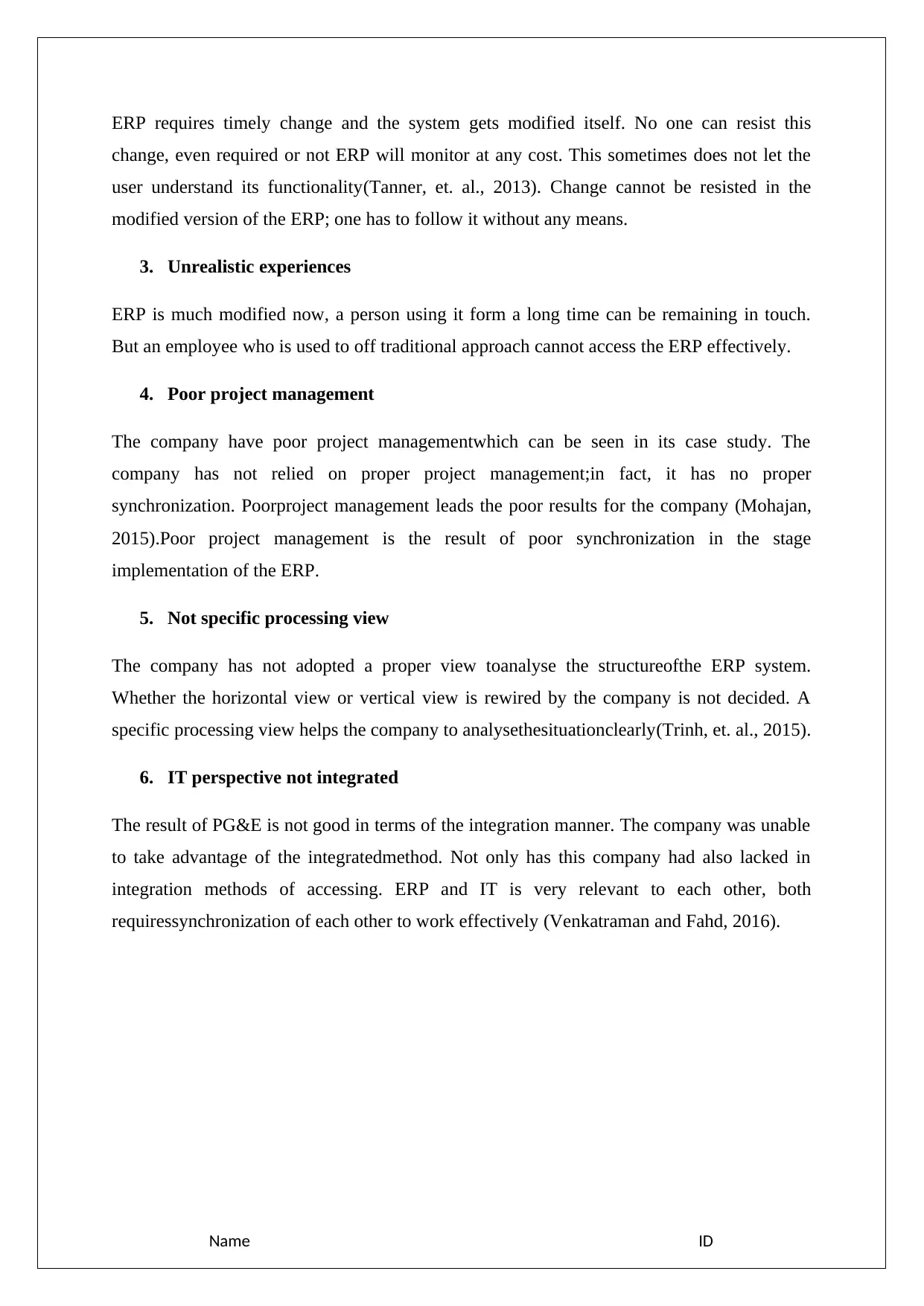
ERP requires timely change and the system gets modified itself. No one can resist this
change, even required or not ERP will monitor at any cost. This sometimes does not let the
user understand its functionality(Tanner, et. al., 2013). Change cannot be resisted in the
modified version of the ERP; one has to follow it without any means.
3. Unrealistic experiences
ERP is much modified now, a person using it form a long time can be remaining in touch.
But an employee who is used to off traditional approach cannot access the ERP effectively.
4. Poor project management
The company have poor project managementwhich can be seen in its case study. The
company has not relied on proper project management;in fact, it has no proper
synchronization. Poorproject management leads the poor results for the company (Mohajan,
2015).Poor project management is the result of poor synchronization in the stage
implementation of the ERP.
5. Not specific processing view
The company has not adopted a proper view toanalyse the structureofthe ERP system.
Whether the horizontal view or vertical view is rewired by the company is not decided. A
specific processing view helps the company to analysethesituationclearly(Trinh, et. al., 2015).
6. IT perspective not integrated
The result of PG&E is not good in terms of the integration manner. The company was unable
to take advantage of the integratedmethod. Not only has this company had also lacked in
integration methods of accessing. ERP and IT is very relevant to each other, both
requiressynchronization of each other to work effectively (Venkatraman and Fahd, 2016).
Name ID
change, even required or not ERP will monitor at any cost. This sometimes does not let the
user understand its functionality(Tanner, et. al., 2013). Change cannot be resisted in the
modified version of the ERP; one has to follow it without any means.
3. Unrealistic experiences
ERP is much modified now, a person using it form a long time can be remaining in touch.
But an employee who is used to off traditional approach cannot access the ERP effectively.
4. Poor project management
The company have poor project managementwhich can be seen in its case study. The
company has not relied on proper project management;in fact, it has no proper
synchronization. Poorproject management leads the poor results for the company (Mohajan,
2015).Poor project management is the result of poor synchronization in the stage
implementation of the ERP.
5. Not specific processing view
The company has not adopted a proper view toanalyse the structureofthe ERP system.
Whether the horizontal view or vertical view is rewired by the company is not decided. A
specific processing view helps the company to analysethesituationclearly(Trinh, et. al., 2015).
6. IT perspective not integrated
The result of PG&E is not good in terms of the integration manner. The company was unable
to take advantage of the integratedmethod. Not only has this company had also lacked in
integration methods of accessing. ERP and IT is very relevant to each other, both
requiressynchronization of each other to work effectively (Venkatraman and Fahd, 2016).
Name ID
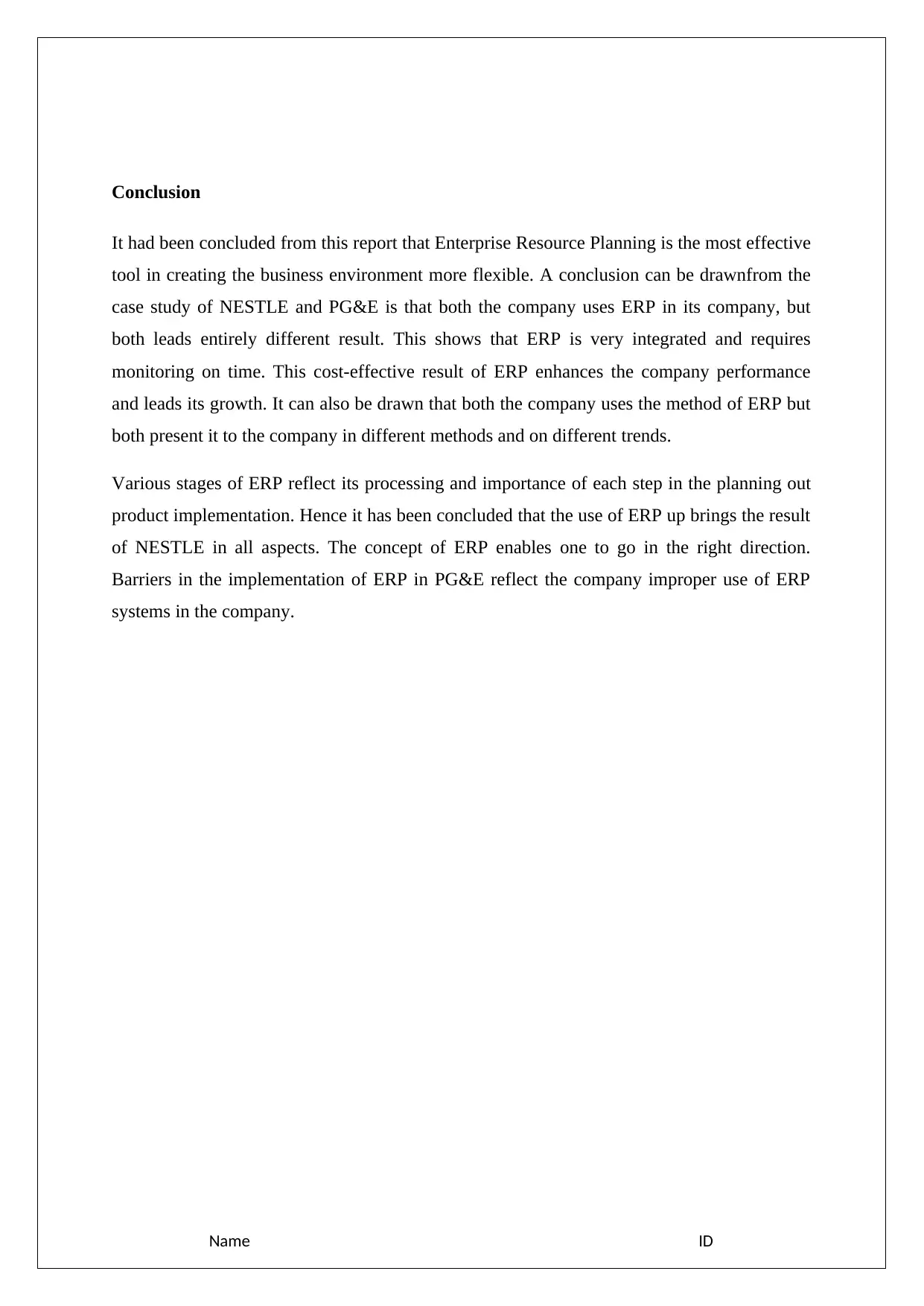
Conclusion
It had been concluded from this report that Enterprise Resource Planning is the most effective
tool in creating the business environment more flexible. A conclusion can be drawnfrom the
case study of NESTLE and PG&E is that both the company uses ERP in its company, but
both leads entirely different result. This shows that ERP is very integrated and requires
monitoring on time. This cost-effective result of ERP enhances the company performance
and leads its growth. It can also be drawn that both the company uses the method of ERP but
both present it to the company in different methods and on different trends.
Various stages of ERP reflect its processing and importance of each step in the planning out
product implementation. Hence it has been concluded that the use of ERP up brings the result
of NESTLE in all aspects. The concept of ERP enables one to go in the right direction.
Barriers in the implementation of ERP in PG&E reflect the company improper use of ERP
systems in the company.
Name ID
It had been concluded from this report that Enterprise Resource Planning is the most effective
tool in creating the business environment more flexible. A conclusion can be drawnfrom the
case study of NESTLE and PG&E is that both the company uses ERP in its company, but
both leads entirely different result. This shows that ERP is very integrated and requires
monitoring on time. This cost-effective result of ERP enhances the company performance
and leads its growth. It can also be drawn that both the company uses the method of ERP but
both present it to the company in different methods and on different trends.
Various stages of ERP reflect its processing and importance of each step in the planning out
product implementation. Hence it has been concluded that the use of ERP up brings the result
of NESTLE in all aspects. The concept of ERP enables one to go in the right direction.
Barriers in the implementation of ERP in PG&E reflect the company improper use of ERP
systems in the company.
Name ID

References
Ahmad, M.M. and Cuenca, R.P., 2013. Critical success factors for ERP implementation
in SMEs. Robotics and computer-integrated manufacturing, 29(3), pp.104-111.
Akbarova, K., 2017. The Effect Of Product’s Color And Fabric Quality On Brand
Preference: A Study In Fashion Retailers In Turkey (Doctoral Dissertation, Istanbul
Aydin University Institute Of Social Sciences).
Bolten, A.S. and Gomez, J.M., 2012. A successful ERP implementation in an Ethiopian
company: A case study of ERP implementation in Mesfine industrial engineering Pvt.
Ltd. Procedia Technology, 5, pp.40-49.
Bradford, M., 2015. Modern ERP: select, implement and use today's advanced business
systems. Lulu. com.
Fillion, G., Braham, H. and Ekionea, J.P.B., 2012. Testing UTAUT on the use of ERP
systems by middle managers and end-users of medium-to-large-sized Canadian
enterprises. Academy of Information & Management Sciences Journal, 15(2).
Harwood, S., 2017. ERP: The implementation cycle. Routledge.
HassabElnaby, H.R., Hwang, W. and Vonderembse, M.A., 2012. The impact of ERP
implementation on organizational capabilities and firm performance. Benchmarking: An
International Journal, 19(4/5), pp.618-633.
Khaparde, V.M., 2012. Barriers of ERP while implementing ERP: A Literature
Review. Journal of Mechanical and Civil Engineering, 3(6), pp.49-91.
Lijap, O., Alfredo, L. and Ponce de León Jara, G.M., 2015. Strategic plan for Creamás.
Madapusi, A. and D'Souza, D., 2012. The influence of ERP system implementation on
the operational performance of an organization. International Journal of Information
Management, 32(1), pp.24-34.
May, J., Dhillon, G. and Caldeira, M., 2013. Defining value-based objectives for ERP
systems planning. Decision Support Systems, 55(1), pp.98-109.
Mohajan, H., 2015. Present and Future of Nestlé Bangladesh Limited.
Muller, M., 2013. Nestlé baby milk scandal has grown up but not gone away. The
Guardian, 13.
Peng, G.C.A. and Gala, C., 2014. Cloud ERP: a new dilemma to modern
organisations?. Journal of Computer Information Systems, 54(4), pp.22-30.
Name ID
Ahmad, M.M. and Cuenca, R.P., 2013. Critical success factors for ERP implementation
in SMEs. Robotics and computer-integrated manufacturing, 29(3), pp.104-111.
Akbarova, K., 2017. The Effect Of Product’s Color And Fabric Quality On Brand
Preference: A Study In Fashion Retailers In Turkey (Doctoral Dissertation, Istanbul
Aydin University Institute Of Social Sciences).
Bolten, A.S. and Gomez, J.M., 2012. A successful ERP implementation in an Ethiopian
company: A case study of ERP implementation in Mesfine industrial engineering Pvt.
Ltd. Procedia Technology, 5, pp.40-49.
Bradford, M., 2015. Modern ERP: select, implement and use today's advanced business
systems. Lulu. com.
Fillion, G., Braham, H. and Ekionea, J.P.B., 2012. Testing UTAUT on the use of ERP
systems by middle managers and end-users of medium-to-large-sized Canadian
enterprises. Academy of Information & Management Sciences Journal, 15(2).
Harwood, S., 2017. ERP: The implementation cycle. Routledge.
HassabElnaby, H.R., Hwang, W. and Vonderembse, M.A., 2012. The impact of ERP
implementation on organizational capabilities and firm performance. Benchmarking: An
International Journal, 19(4/5), pp.618-633.
Khaparde, V.M., 2012. Barriers of ERP while implementing ERP: A Literature
Review. Journal of Mechanical and Civil Engineering, 3(6), pp.49-91.
Lijap, O., Alfredo, L. and Ponce de León Jara, G.M., 2015. Strategic plan for Creamás.
Madapusi, A. and D'Souza, D., 2012. The influence of ERP system implementation on
the operational performance of an organization. International Journal of Information
Management, 32(1), pp.24-34.
May, J., Dhillon, G. and Caldeira, M., 2013. Defining value-based objectives for ERP
systems planning. Decision Support Systems, 55(1), pp.98-109.
Mohajan, H., 2015. Present and Future of Nestlé Bangladesh Limited.
Muller, M., 2013. Nestlé baby milk scandal has grown up but not gone away. The
Guardian, 13.
Peng, G.C.A. and Gala, C., 2014. Cloud ERP: a new dilemma to modern
organisations?. Journal of Computer Information Systems, 54(4), pp.22-30.
Name ID
Paraphrase This Document
Need a fresh take? Get an instant paraphrase of this document with our AI Paraphraser
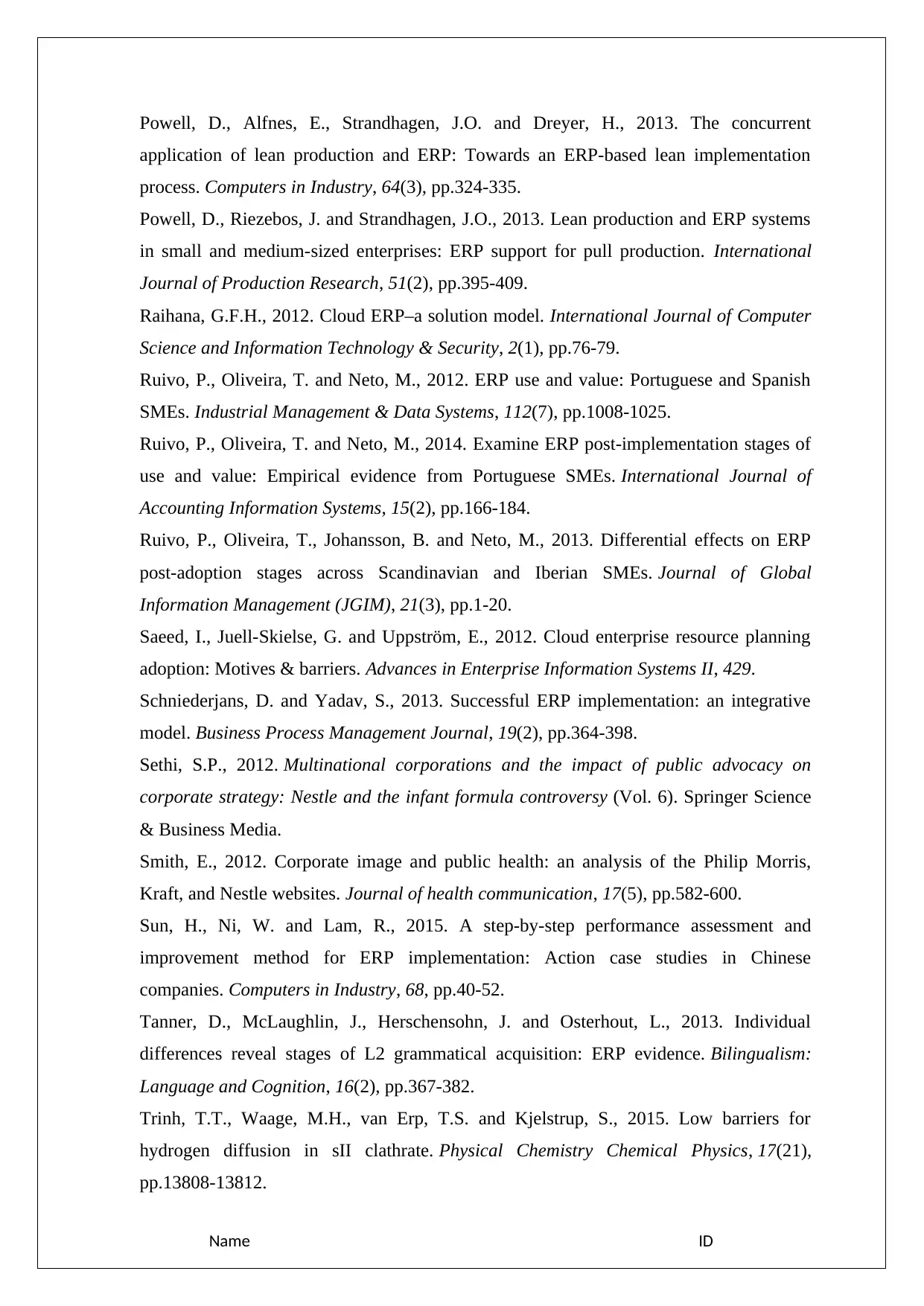
Powell, D., Alfnes, E., Strandhagen, J.O. and Dreyer, H., 2013. The concurrent
application of lean production and ERP: Towards an ERP-based lean implementation
process. Computers in Industry, 64(3), pp.324-335.
Powell, D., Riezebos, J. and Strandhagen, J.O., 2013. Lean production and ERP systems
in small and medium-sized enterprises: ERP support for pull production. International
Journal of Production Research, 51(2), pp.395-409.
Raihana, G.F.H., 2012. Cloud ERP–a solution model. International Journal of Computer
Science and Information Technology & Security, 2(1), pp.76-79.
Ruivo, P., Oliveira, T. and Neto, M., 2012. ERP use and value: Portuguese and Spanish
SMEs. Industrial Management & Data Systems, 112(7), pp.1008-1025.
Ruivo, P., Oliveira, T. and Neto, M., 2014. Examine ERP post-implementation stages of
use and value: Empirical evidence from Portuguese SMEs. International Journal of
Accounting Information Systems, 15(2), pp.166-184.
Ruivo, P., Oliveira, T., Johansson, B. and Neto, M., 2013. Differential effects on ERP
post-adoption stages across Scandinavian and Iberian SMEs. Journal of Global
Information Management (JGIM), 21(3), pp.1-20.
Saeed, I., Juell-Skielse, G. and Uppström, E., 2012. Cloud enterprise resource planning
adoption: Motives & barriers. Advances in Enterprise Information Systems II, 429.
Schniederjans, D. and Yadav, S., 2013. Successful ERP implementation: an integrative
model. Business Process Management Journal, 19(2), pp.364-398.
Sethi, S.P., 2012. Multinational corporations and the impact of public advocacy on
corporate strategy: Nestle and the infant formula controversy (Vol. 6). Springer Science
& Business Media.
Smith, E., 2012. Corporate image and public health: an analysis of the Philip Morris,
Kraft, and Nestle websites. Journal of health communication, 17(5), pp.582-600.
Sun, H., Ni, W. and Lam, R., 2015. A step-by-step performance assessment and
improvement method for ERP implementation: Action case studies in Chinese
companies. Computers in Industry, 68, pp.40-52.
Tanner, D., McLaughlin, J., Herschensohn, J. and Osterhout, L., 2013. Individual
differences reveal stages of L2 grammatical acquisition: ERP evidence. Bilingualism:
Language and Cognition, 16(2), pp.367-382.
Trinh, T.T., Waage, M.H., van Erp, T.S. and Kjelstrup, S., 2015. Low barriers for
hydrogen diffusion in sII clathrate. Physical Chemistry Chemical Physics, 17(21),
pp.13808-13812.
Name ID
application of lean production and ERP: Towards an ERP-based lean implementation
process. Computers in Industry, 64(3), pp.324-335.
Powell, D., Riezebos, J. and Strandhagen, J.O., 2013. Lean production and ERP systems
in small and medium-sized enterprises: ERP support for pull production. International
Journal of Production Research, 51(2), pp.395-409.
Raihana, G.F.H., 2012. Cloud ERP–a solution model. International Journal of Computer
Science and Information Technology & Security, 2(1), pp.76-79.
Ruivo, P., Oliveira, T. and Neto, M., 2012. ERP use and value: Portuguese and Spanish
SMEs. Industrial Management & Data Systems, 112(7), pp.1008-1025.
Ruivo, P., Oliveira, T. and Neto, M., 2014. Examine ERP post-implementation stages of
use and value: Empirical evidence from Portuguese SMEs. International Journal of
Accounting Information Systems, 15(2), pp.166-184.
Ruivo, P., Oliveira, T., Johansson, B. and Neto, M., 2013. Differential effects on ERP
post-adoption stages across Scandinavian and Iberian SMEs. Journal of Global
Information Management (JGIM), 21(3), pp.1-20.
Saeed, I., Juell-Skielse, G. and Uppström, E., 2012. Cloud enterprise resource planning
adoption: Motives & barriers. Advances in Enterprise Information Systems II, 429.
Schniederjans, D. and Yadav, S., 2013. Successful ERP implementation: an integrative
model. Business Process Management Journal, 19(2), pp.364-398.
Sethi, S.P., 2012. Multinational corporations and the impact of public advocacy on
corporate strategy: Nestle and the infant formula controversy (Vol. 6). Springer Science
& Business Media.
Smith, E., 2012. Corporate image and public health: an analysis of the Philip Morris,
Kraft, and Nestle websites. Journal of health communication, 17(5), pp.582-600.
Sun, H., Ni, W. and Lam, R., 2015. A step-by-step performance assessment and
improvement method for ERP implementation: Action case studies in Chinese
companies. Computers in Industry, 68, pp.40-52.
Tanner, D., McLaughlin, J., Herschensohn, J. and Osterhout, L., 2013. Individual
differences reveal stages of L2 grammatical acquisition: ERP evidence. Bilingualism:
Language and Cognition, 16(2), pp.367-382.
Trinh, T.T., Waage, M.H., van Erp, T.S. and Kjelstrup, S., 2015. Low barriers for
hydrogen diffusion in sII clathrate. Physical Chemistry Chemical Physics, 17(21),
pp.13808-13812.
Name ID
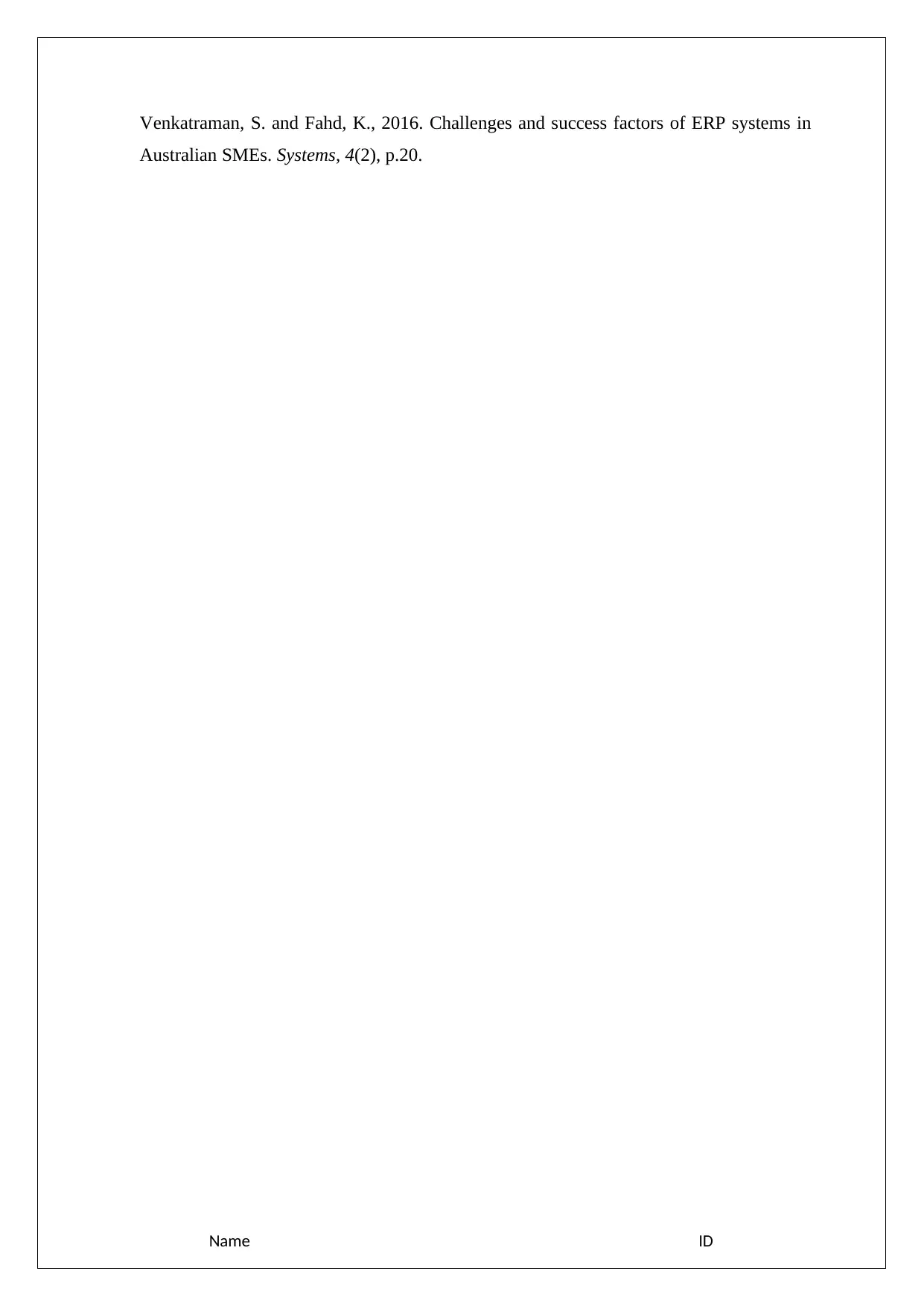
Venkatraman, S. and Fahd, K., 2016. Challenges and success factors of ERP systems in
Australian SMEs. Systems, 4(2), p.20.
Name ID
Australian SMEs. Systems, 4(2), p.20.
Name ID
1 out of 21
Related Documents
Your All-in-One AI-Powered Toolkit for Academic Success.
+13062052269
info@desklib.com
Available 24*7 on WhatsApp / Email
![[object Object]](/_next/static/media/star-bottom.7253800d.svg)
Unlock your academic potential
© 2024 | Zucol Services PVT LTD | All rights reserved.





